#satsuma hayato
Text
excuse for lateness but HAPPY BIRTHDAY TO THE CHAOTIC SECOND LIEUTENANT AND THE ONE AND ONLY SATSUMA HAYATO, KOITO OTONOSHIN


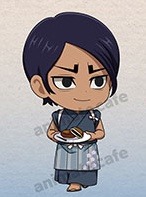
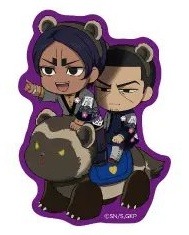
9 notes
·
View notes
Note
1, 2, or 3 (or all three if you want)
3 - What shows have you watched so far?
Rider: Stronger, Shin, Kuuga, Agito, Ryuki, Faiz, Blade, Hibiki, Kabuto, Kiva, Decade, W + Fuuto PI, OOO, Fourze, Wizard, Gaim, Drive, Ghost, Ex-Aid, Build, Zi-O, Zero-One, Saber, Revice, and caught up on Geats
Sentai: JAKQ, Liveman, Jetman, Gokaiger, Go-Busters, Kyuranger, LuPat, Ryusoulger, Zenkaiger, and High School Heroes
Power Rangers: MMPR, In Space, Lost Galaxy, Timeforce, Ninja Storm, Dino Thunder, Mystic Force, Jungle Fury, RPM, Samurai, Super Megaforce, but not Megaforce (I was 10 so sue me), Ninja Steel, Dino Fury. PR 2017 also. Read the comics through shattered grid but the next arc killed me.
Ultraman: Orb, Taiga
GARO: og, YamiTera, Jinga, Black Blood, and VR
Other: Zubat, Tokusatsu Gagaga, Girl Gun Lady, and Satsuma Kenshi Hayato
3 notes
·
View notes
Text
[Character Introduction] Otonoshin Koito
เข้าสู่ช่วงแนะนำตัวละคร “Otonoshin Koito”
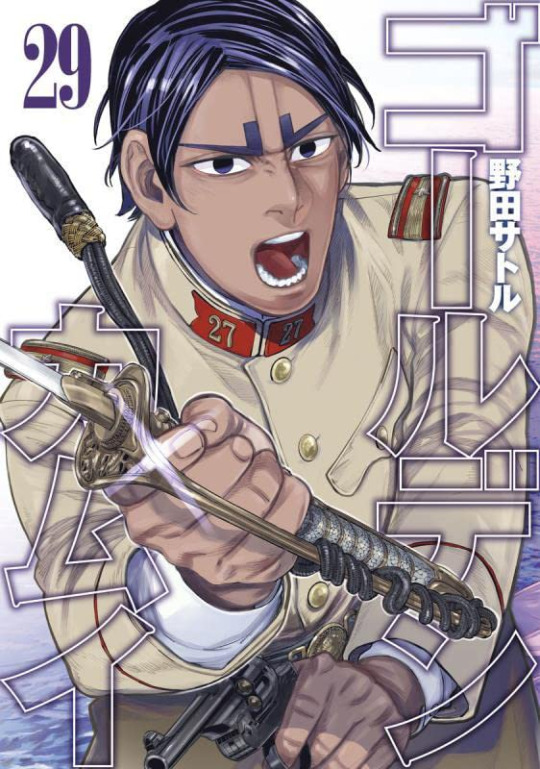
ชื่อ : โอโตโนะชิน โคอิโตะ, Otonoshin Koito (鯉登 音之進)
ชื่ออื่นๆ : Satsuma Hayato (薩摩隼人)
วันเกิด : 23 ธันวาคม 1886
ส่วนสูง : 173 ซม.
สมาชิกครอบครัว (ที่ปรากฎในเรื่อง) : พ่อ,แม่,พี่ชาย
โคอิโตะ รองหัวหน้าหน่วยที่ 7 โคอิโตะ ชายหนุ่มผู้กระฉับกระเฉง เป็นคนที่มีความสามารถแต่ใจร้อน เขาทุ่มเทความศรัทธาทั้งหมดให้กับ ร.ท. สึรุมิ และต้องการเป็นทหารชั้นพิเศษซึ่งคู่ควรกับชื่อเสียงครอบครัวของเขา
โคอิโตะเป็นชายร่างสูงผิวดำที่มีต้นกำเนิดจากฮายาโตะ* (隼人) เขามีผมสีเข้มโทนสีม่วงหยักศกเล็กน้อยที่ผ่าแล้วปัดไปทางซ้าย คิ้วเชิงมุมขนาดใหญ่ของเขาทำให้มองดูเหมือนขมวดคิ้วตลอดเวลา และมีเส้นขมวดคิ้วที่ชัดเจนสองเส้นปรากฏบนหน้าผากของเขา ตาของเขาดำ เล็ก และมีถุงใต้ตาลึก
โคอิโตะสวมเครื่องแบบ Meiji 38* ซึ่งส่วนใหญ่จะเหมือนกับเครื่องแบบทหารทั่วไป แต่เป็นสีกากีแทนที่จะเป็นสีน้ำเงิน เขาสวมเสื้อโค้ทสีกากีแบบติดกระดุมแบบสั้น มีกระเป๋า 2 ข้างที่หน้าอก และกระเป๋า 2 ข้างที่ด้านข้าง โดยมีปกสีแดงที่ปกเสื้อ พร้อมพิมพ์หมายเลขกรมทหาร 27 ทั้งสองข้าง เครื่องราชอิสริยาภรณ์ที่โคอิโตะสวมเป็นสีแดง ที่มีขอบสีทองและมีแถบสีทองหนึ่งเส้นตัดผ่าน โดยมีดาวสีทองอยู่ตรงกลาง แผ่นไหล่ของเครื่องแบบของเขาที่ถูกวางในแนวตั้ง เครื่องราชอิสริยาภรณ์ที่แขนเสื้อมีเส้นสีแดงบาง ๆ บนแขนแต่ละข้างและดาวสีทองขนาดเล็ก
โคอิโตะสวมเข็มขัดที่มีหัวเข็มขัดทรงกลมผูกไว้เหนือเสื้อโค้ทของเขา และกางเกงสีกรมท่าสีเข้มที่มีแถบสีแดงซึ่งซ่อนอยู่ในรองเท้าบูทหนังทหารของเขา ปกติเขาไม่สวมหมวกทหาร ในสภาพอากาศที่หนาวเย็น โคอิโตะจะสวมเสื้อคลุมยาวสีกากีกระดุมสองแถว คลุมคอเสื้อ บนไหล่มีตราเหมือนกันกับชุดประจำของเขา โคอิโตะยังสวมถุงมือหนังด้วย
โคอิโตะเป็นนายร้อยหนุ่มที่มีทักษะ แต่ค่อนข้างไร้เดียงสา ประหลาด อึกทึก และยังไม่บรรลุนิติภาวะ คล่องแคล่วว่องไวและฉลาดอย่างเหลือเชื่อ เขาได้แสดงให้เห็นถึงทักษะการต่อสู้มากมายในเรื่อง และได้รับการพิสูจน์ว่า ค่อนข้างโหดเหี้ยม หากถูกผลักดัน เนื่องจากการที่พ่อของโคอิโตะ ได้หยุดเขาจากความพยายามที่จะเข้าร่วมในสงครามรัสเซีย-ญี่ปุ่น ทำให้เขาขาดประสบการณ์และมักได้รับการปกป้องอยู่เสมอ บ่อยครั้งนำไปสู่พฤติกรรมที่สามารถอธิบายได้ว่านิสัยเสีย เขามักมีนิสัยชอบความฟุ่มเฟือยและขี้เล่น
โคอิโตะมีความชื่นชมต่อสึรุมิเป็นอย่างมาก และโอกาตะกล่าวถึงเขาว่าเป็น Satsuma Hayato คนโปรดของสึรุมิ เขาทุ่มเทให้กับ ร.ท.มากจนดูเหมือนเป็นความรักที่ไร้เหตุผล เขายังตัดใบหน้าของคนอื่นทั้งหมดในรูปถ่ายของหน่วยที่ 7 ออก และนำรูปของตัวเองแปะทับ จนกลายเป็นรูปที่มีเพียงเขาและ ร.ท. การกระทำเช่นนี้แสดงให้เห็นระดับของการบูชาสึรุมิของโคอิโตะ เช่นเดียวกัน การเน้นย้ำถึงความทะเยอทะยานของโคอิโตะ เมื่อโคอิโตะและสึกิชิมะเริ่มทำงานด้วยกัน เขาได้สั่งให้สึกิชิมะบอกทุกอย่างเกี่ยวกับสึรุมิที่เขายังไม่รู้ โคอิโตะต้องการเป็นทหารที่น่าเคารพนับถือแบบพ่อของเขาและ ร.ท. นอกจากนี้เขายังมีทักษะที่น่าสนใจและต้องการการฝึกฝนเพิ่มเติม เช่น ทักษะการใช้ดาบและการเป็นนักวิ่งที่ดี
โคอิโตะมีความสัมพันธ์ที่ดีกับสึกิชิมะ ซึ่งช่วยให้เขาไต่อันดับไปยังตำแหน่งรองหัวหน้าหน่วย โคอิโตะเชื่อใจสึกิชิมะมาก เขาไว้ใจให้สึกิชิมะเป็นคนส่งต่อคำพูดหรือคำสั่งของตน โคอิโตะค่อนข้างสุภาพเมื่อพบใครบางคนเป็นครั้งแรก แต่ในไม่ช้าเขาก็แสดงให้เห็นว่าเขาทื่อ และมักจะแสดงความคิดเห็นโดยไม่คิด เพราะเป็นบุตรนายทหารระดับสูง เขาจึงต้องการความเอาใจใส่เป็นพิเศษ เขายอมจ่ายเงินเพื่อสุนัขลากเลื่อน และพักโรงแรมในเมืองใหญ่แทนที่จะพักที่โคตัน
เนื่องจากโคอิโตะมาจากจังหวัดซัตสึมะ (薩摩藩) ซึ่งอยู่ทางตอนใต้สุดของญี่ปุ่น เขาจึงเผลอพูดภาษาถิ่นออกไปในบางครั้ง สิ่งนี้มักเกิดขึ้นเมื่อเขาตื่นเต้นหรือประหม่า อย่างไรก็ตาม คนญี่ปุ่นส่วนใหญ่ไม่ค่อยรู้หรือเข้าใจในภาษาถิ่นของซัตสึมะ
เนื่องจากการตายของพี่ชายของโคอิโตะ เมื่อใดก็ตามที่เขาอยู่บนเรือเป็นเวลานาน เขาจะเริ่มคิดถึงพี่ชายของเขาและเมาเรืออย่างหนัก เพราะอาการนี้ เขาจึงเสียใจที่ไม่สามารถเป็นนายทหารเรือที่ยิ่งใหญ่ได้ แม้จะมาจากครอบครัวทหารเรือที่เป็นที่ยอมรับ
มาพูดถึงอาวุธประจำตัวของโคอิโตะค่ะ
ปืน Revolver Type 26
ดาบทหาร Gunto (軍刀)
Fun Facts ของโคอิโตะ
ตัวคันจิในชื่อของโคอิโตะ (鯉登 音之進) (鯉) Carp (登) Rise (音) Sound (之進) Ancient job title name for Samurai
โคอิโตะต่อสู้ในสไตล์ของจิเก็น-ริว (Jigen-Ryu) อันที่จริงแล้วเสียงกรีดร้องที่โดดเด่นของเขาเป็นองค์ประกอบของจิเก็น-ริว ซึ่งเป็นเสียงร้องของลิง
โคอิโตะใช้ภาษาถิ่นซัตสึมะได้อย่างคล่องแคล่ว แม้ว่าปกติแล้วเขาจะหลุดพูดเมื่อเขาตื่นเต้นหรืออยู่ใกล้กับ ร.ท.
ในปี 2018 โพลสำรวจความนิยม GK All-Stars โคอิโตะ อยู่ในอันดับที่ 5 ด้วยคะแนนโหวต 7,134 คะแนน
อายุของโคอิโตะ มากกว่าโอคุยามะ เท่ากับเอโดะไก น้อยกว่าสุกิโมโตะ ทานิคากิ นิไคโด และอาริโกะ
โคอิโตะชอบกินขนมปัง Tsukisamu และไม่ชอบกิน หัวไช้เท้า Sakurajima
ส่วนสูงของโคอิโตะ น้อยกว่าสุกิโมโตะ โทนิ และ Wilk เท่ากับสึรุมิ มากกว่าเอโดะไก
น้ำหนักของโคอิโตะ น้อยกว่าโทนิ มากกว่าโอกาตะ คู่แฝดนิไคโด อุซามิ และ Wilk
ถ้าตัวละครมีชีวิตในยุคปัจจุบัน พวกเขาจะประกอบอาชีพอะไร อ.โนดะตอบว่า พนักงานขายเสื้อผ้าผู้ชายในอิเซตัน
อ.โนดะเปรียบเทียบความสัมพันธ์ระหว่าง โคอิโตะและสึกิชิมะ กับ "เจ้าหญิงนิสัยเสีย ลักษณะทอมบอยและสาวใช้ที่ทำหน้าที่เป็นครู"
การเลือกเครื่องแบบของโคอิโตะ อาจสะท้อนถึงความไม่มีประสบการณ์ของเขา อันเป็นผลมาจากการถูกห้ามเข้าร่วมในสงครามรัสเซีย-ญี่ปุ่น เขาสวมเครื่องแบบเมจิ 38 รุ่นใหม่ที่เปิดตัวในปี 1906 ในขณะที่เพื่อนร่วมงานของเขายังคงเครื่องแบบ "สีน้ำเงิน" แบบเก่า นั่นคือเมจิ 19 ซึ่งเปิดตัวในปี 1889 เนื่องจากทหารประจำการในหมู่เกาะบ้านเกิดของเขามักจะได้รับเครื่องแบบใหม่ก่อนสหายของพวกเขาจะไปสู้รบในต่างประเทศ
Source :
Golden Kamuy official fanbook
Golden Kamuy Manga
Golden Kamuy Fandom
Golden Kamuy Central, @/KamuyCentral, Twitter
Kamuy Central Wordpress
0 notes
Text
Yamato: People primarily of Yayoi descent after the Yayoi migration
Emishi: People primarily of Jomon descent after the Yayoi migration
Ainu: Last descendants of the Emishi in Hokkaido
Hayato: were a people of ancient Japan who lived in the Satsuma and Ōsumi regions of southern Kyushu during the Nara period. They frequently resisted Yamato rule. After their subjugation they became subjects of the government under Ritsuryō, and the Ministry of the Military had an office known as the Hayato-shi (隼人司) in charge of their governance. The name also came into use by samurai as a title, Hayato no suke (隼人助).The Hayato might have been the same as the Kumaso group of around the same time, but while the Kumaso are mentioned in the more legendary portions of the Nihon Shoki, the Hayato are recorded in various historical texts until the beginning of the Heian period. Though the Kumaso are generally portrayed as rebellious, the Hayato are listed among the attendants of emperors and princes from as early as Emperor Nintoku's reign. This, along with a mention of Hayato crying before the grave of Emperor Yūryaku after his death, suggests that the Hayato were naturalized as personal servants by the late 7th century.Even after pledging allegiance to the Japanese court, the Hayato continued to resist its rule. After the establishment of Ōsumi Province in 713, the Ōsumi Hayato fought back in 720 with the Hayato Rebellion, but were defeated in 721 by an army led by Ōtomo no Tabito. The Handen-Shūju system was implemented in their lands in 800. The population of Yamato immigrants in Kagoshima prefecture in the early 8th century has been estimated at around 9,000 people and one-seventh of the total population. By this estimate, the Hayato population of the time can be calculated as consisting of around 54,000 people (not including Hayato emigrants to Honshū).The language spoken by the Hayato is not known, except for two words and several personal names documented in contemporary sources. Based on this material, it has been proposed that the Hayato may have been of Austronesian origin. Their culture is also believed to be unique from those of other regions of Japan. In particular, their folk song and dance became famous in the Kinai region as the Hayato dance (隼人舞). An excavation of Heijō Palace discovered wooden shields with a distinctive reverse-S-shaped marking. These shields match those described in the Engishiki, which the Hayato used in court ceremonial functions. The Hayato had roles in various state ceremonies, including those for the new year, imperial enthronement, and visiting foreign officials.According to the ancient records of Hizen province, the Gotō Islands were also inhabited by a people resembling the Hayato. The New Book of Tang describes a minor king of Haya (波邪), and this Haya has also been interpreted as referring to the Hayato.
Kumaso
Oroks: Lived in eastern Russia (Sakhalin) and Hokkaido
Okinawa: The largest of the Ryuku Islands, there is a separatist movement which is believed to be supported by the CCP.
The Kuzu were a people of ancient Japan believed to have lived along the Yoshino River in Nara Prefecture. They were mentioned in the Kojiki and Nihon Shoki. The name was also used for a population living in the old Hitachi province (today's Ibaraki Prefecture) mentioned by the Hitachi Fudoki.
Their name may be at the origin of the name of the kudzu plant, supposedly for being associated with the harvest and sale of kudzu roots or starch extracted from them.
They probably spoke a Japonic languages, but like the Izumo, distinct from Japanese.
The Izumo were an ancient Japonic-speaking ethnic group and a rival to the Yamato Japanese. They were defeated by the Yamato and disappeared from any historical mention.
Some recent historians argue that the Emishi of Tohoku are the Izumo which escaped from the Yamato, and created a tribal union uniting different groups to resist the emerging Yamato empire.
These various tribes probably resembled Northeast Asians and or Indigenous Taiwanese tribes respectively:
Amami
Miyako
Yaeyama
Yonaguni
Azumi
Mishihase
Saeki
Kumabito
“Tsuchigumo “
1 note
·
View note
Text
Koito Otonoshin is from Kagoshima; what does the city and area reveal about his character.
While on holiday, I was very lucky to have a chance to visit Koito’s very own hometown of Kagoshima, in Kagoshima Prefecture on the southwestern part of Kyushu. I’ve grown more attached to Koito’s character as the manga has developed and I’m more curious to try to figure out what he will do in the manga now that he has been “reunited” with Tsurumi. So, I figured why not go visit his hometown in January when the weather will be lovely [it was]. I will admit that I tricked my Mom to go with me not knowing it was a Koito research trip, but at least told my brother. He was fine with it since he had wanted to visit the nearby Miyazaki prefecture anyways.
This will be a little bit of a different meta post as I’ll present things I observed and try to place Koito in the context of them. This is based on my opinion and how I interpreted and observed things around me. Please keep that in mind when reading!

To get to Kagoshima, I took full advantage of the JR Rail pass for tourists and left from Kyoto to Kagoshima-chuo, the main train station with a transfer at Shin-Kobe. I went down in early January and it was lovely to see the scenery become more green as I went further south. Kyushu has a different feel than the island of Honshu, you see subtropical and tropical plants and it really feels different than other parts of Japan that I have visited e.g. Tokyo, Kyoto and Osaka. This was my first time visiting Kyushu and I really loved the southern part of the island.
If you are using a rail pass to get there, it will take you some time, it was about 5 hours or so in total from Kyoto. If you go from Tokyo, it will take at least 7 hours and that is just from Kagoshima-chuo to Shinagawa (Tokyo area) station. If you are unable to use a JR pass, like my brother who is currently working in Japan, or you have very limited time, the best option is to fly, say from Tokyo-Haneda to the Kagoshima airport (40 min bus ride from downtown Kagoshima).

The most obvious thing about Kagoshima and the area, is how different it is than parts of Honshu. The entire area has that tropical/subtropical feel. It was January and the weather was quite pleasant, around 14-16 degrees C as the high during the day and lows around 7 or so. It was sunny and there were flowers blooming everywhere in gardens and parks and you are right next to the bay! It was so lovely.
I have somewhat limited travel experience in Japan only able to previously visit cities like Nagoya (for work), Gifu (for work but Oda Nobunaga!), Kyoto, Nara, Osaka, Hiroshima, Tokyo and Shizuoka (for maguro tuna) before this trip. What I can say from the start is the feel and look of Kagoshima is different than these other cities. There are more colorful buildings in Kagoshima, some were green, lime green, light pink, magenta and orange intermixed with the more standard, black, grey, white of the modern Japanese landscape. The urban landscape was more varied and interesting than other cities I’ve been to in Japan.
There were many older western style buildings and street lights / lamp posts that looked like they were from 1880-1930. For example here is a public building that clearly looks like it is from 1900-1930 or so. I tried to figure out what it was, but it simply said civic building and likely was now associated with the performing arts center right next to it from about the 1950s/1960s. You can see lots of cycads(!) planted out in front of the building.

The city still runs streetcars that have old lamps as a part of the posts that hold up their electrical cables. I forgot to take a picture of some of the streetcars; half of their cars were old, ~1940s-1950s at the newest as well as sleek modern streetcars. I snapped this photo of the streetcar operator while riding in the city. Yes, it is an old lever operated drive system! It appeared to be made by Mitsubishi, and you can see the flowers blooming in the background.

A great example of a more western style building was this large department store in the downtown part of the city. It is the Yamakataya Department store, and after some quick online searching it appears to have been built around 1917 with other parts added on over time. You can find more photos of it on TripAdvisor.
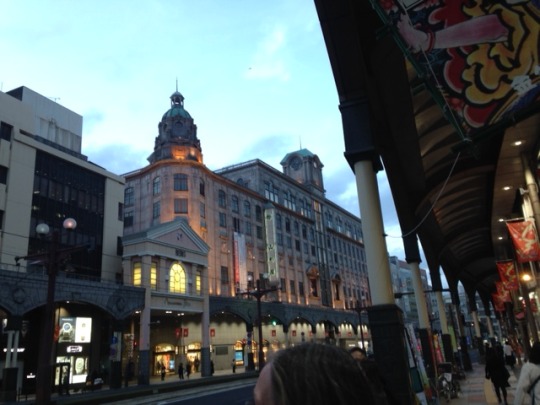
I spotted other older Victorian and turn of the century buildings in the city which added to the unique vibe of the city. While wondering around the local shopping arcades looking for a restaurant, we stumbled upon an interesting glass ceiling at one of the intersection of the arcades. Four locations are shown on the map, Kagoshima, Malacca (Malaysia), Goa (India) and Basque (Spain).
This one shows Kagoshima and Malacca, with ships, churches and random people meeting missionaries, specifically Jesuit missionaries including Francis Xavier, who visited and converted people to Christianity in Kagoshima in 1550.
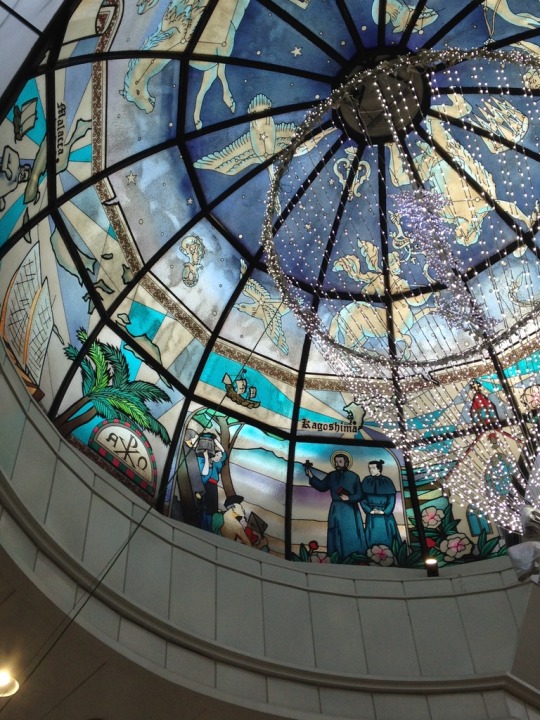
The Basque region of Spain, where Francis Xavier is originally from, though he worked throughout Asia. He was a pretty successful missionary all things considered.

It highlights his time as a missionary in Goa, India
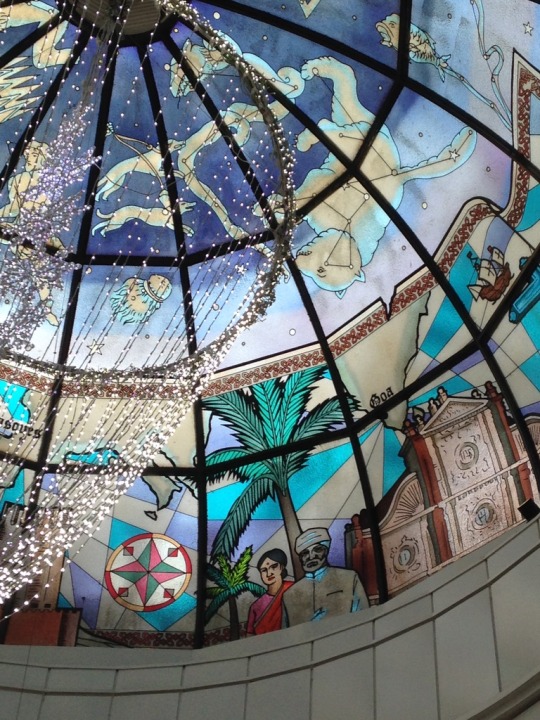
And of course in Kyushu, including Nagasaki and other places as well as Kagoshima. I find it quite curious they have the classic Greek constellations on the sky and not the Japanese ones. It is quite clear that the Jesuit missionaries had an important influence on many people in Kyushu and they still have the highest number of Christians in Japan. I would guess that local people commissioned this artwork since it clearly celebrates the life of Francis Xavier and connects Kagoshima to the other places he lived and worked.
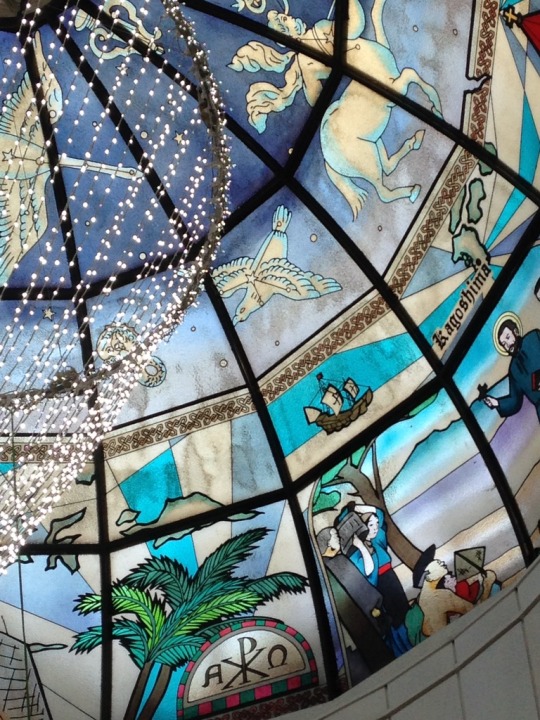
Kagoshima is uniquely situated as how far south it is from both Kyoto and Tokyo [Edo]. By road it is between 800-900 km to Kyoto and 1,300-1,400 km from Tokyo. This implies that it would take a long time before modern technologies in transportation to go between the places of power pre-Edo period and during the Edo period.
I was able to visit Sengan-en an estate of the Shimazu family. The Shimazu family held power in the region since around 1300 and were both powerful warlords, but also successful in international trade due to their location on Kinko Bay. As the Shimazu family were still under the power of the Tokugawa shogunate they were required to journey to Edo, but as a result of the distance, they had the longest overall travel time out of everyone in Japan. I’m sure you can quickly realize that having such a distance from the central government also resulted in the Satsuma domain having more freedom than say a powerful samurai family in Shizuoka.
Even when the Tokugawa shogunate closed off most of the country, this region was still able to trade internationally by proxy through the Ryukyu Islands (Okinawa) and developed more international style cuisine as a result. Sweet potatoes were introduced via Okinawa and the Satsuma sweet potatoes are everywhere. I bought and tried some dried-ish sweet potatoes that looked like twizzlers, but were underwhelming (I think this was a tourist trap, oh look sweet potato things, I’ll try them!). At Sengan-en, we ate some of the baked sweet potatoes of the local variety which were incredibly delicious as just plain potatoes. I’ve had baked sweet potatoes elsewhere in Japan and outside, but this was the best plain baked sweet potato I have every had! I also got sweet potato candy which is delicious, a variant of the famous Bontan Ame (a citrus caramel candy), also invented in Kagoshima! Bontan Ame is also a great candy, I love the subtle citrus flavor.
The sweet potato are the purple caramels on the right and the citrus Bontan Ame on the left. quantivore’s Koito is excited with Tsukishima in between! (quantivore’s artwork can be found on instagram @quantivore ).

Bontan Ame are popular with high school girls . . . for some odd reason I think that Koito would like them too!
I was able to sample some local Kagoshima shouchu, which again, is not surprisingly made from their famous Satsuma sweet potatoes! It tasted good and was pretty strong. I may have had more to drink than I should have with my yakiniku. There were soooo many varieties of shouchu to choose from in the area and they were sold at pretty much every gift shop! I did not buy a bottle since I was afraid to haul it all around Japan and break it on accident.

Recall that the manga highlighted that the Sakurajima daikon are cultivated in the area around the Sakurajima volcano and are the largest daikon in the world as introduced in chapter 197.
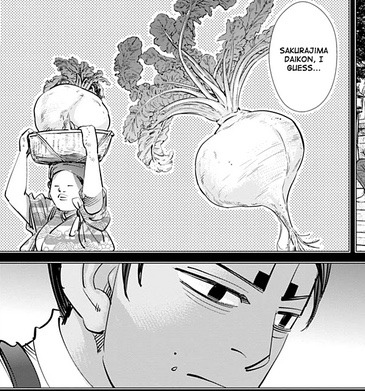
I was unable to see a full daikon in the flesh, while visiting the Sakurajima Geo-Park, I did spot some growing in the ground and you could see large leaves! I really wanted to see a Sakurajima daikon, in person. The daikon was found on public city artwork and designs. I had to settle with only seeing their leafy tops while on a bus, though I bought a small daikon charm and my brother found me a plushie at the airport. I did eat some daikon (already cut to a much smaller size) with the regional black pork which was delicious. The pork was richer than normal ground pork and the daikon melted in your mouth as you ate it cutting through the richness of the pork.
The daikon is important to Koito’s flashback as it helps to introduce his contrast to his older brother, who had a pale complexion like a Sakurajima daikon and tolerated Koito calling him that.
The last major regional produce of the area is citrus! There is so much citrus in the area! The Satsuma oranges (as they are known in the UK) came from the Kagoshima region after they went to war with the British in 1863! As a result of a naval battle between the Shimazu family and their fellow Satsuma retainers, this war only lasted a few days and resulted in great damage to the Kagoshima area. The positive outcome of this was increased positive relations between the Satsuma region and the UK as opposed to the influence the French government had on the dying/declining Tokugawa shogunate in Edo.
Here is a Satsuma orange tree at Sengan-en. It had an info plaque about how after the Anglo-Satsuma war they were popular for import to England.
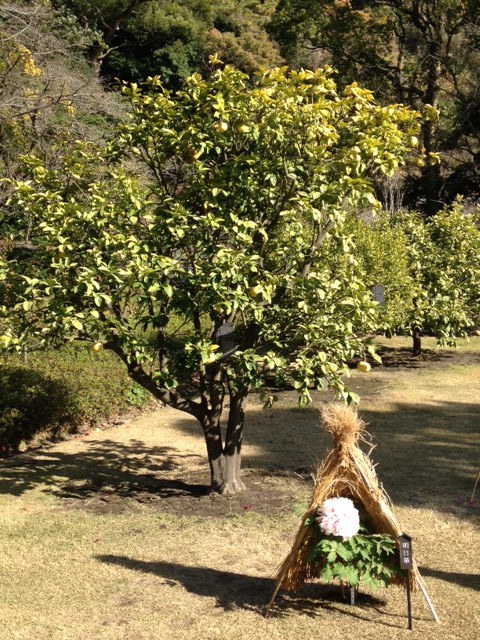
In addition to the Satsuma oranges (aka mikan), there is a distinct variety from the area known as komikan or small mikan. These are grown both on the volcano, Sakurajima (桜島小みかん) and around the Kinko Bay as well (小みかん).
Look at the tiny tiny tiny komikan!
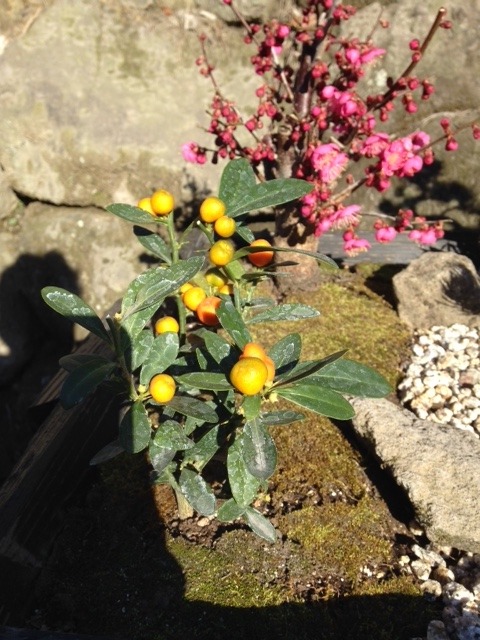
The regular mikan were quite easy to peel and delicious. Throughout the southern part of Kyushu there were lots of different citrus species and cultivars grown. In the neighboring Miyazaki prefecture, they had a yuzu x pomelo hybrid known as a hyuganatsu (also tasty in things!). I digress, the point is Kagoshima as the former Satsuma domain is a place that was able to interact with western nations and it is in part represented by the movement of the citrus fruits from the area to places like the UK and the USA as well where the States actually imported and grew cultivars from the Kagoshima area.
This region was also much more forward thinking that the government in Edo. The Shimazu family were the second largest book publishers in Japan for a very long time and they reprinted Western imported books that included science, technology and maps. I was able to see some of their moveable type for their publishing with both Japanese kanji and kana and the Latin alphabet as well for printing foreign books (I did not spot any Cyrillic, but the museum display was small).
They were the birth of industrial manufacturing in Japan, first trying to build equipment via imported books and later sent students abroad against the rule of the government to study in the UK and the USA. At the grounds of Sengan-en you can visit the first factory in Japan which gives a quick guide in Japanese and English about the development of industrial manufacturing. Unfortunately, you were unable to take pictures in the museum, but they produced various goods including cannons and whatnot which helped in late Bakumatsu period and gave them a weapons advantage over the outdated technology of the Shogunate government forces.
When you get off the train at the main Kagoshima-chuo station and walk towards the bus and streetcar stops, there is a statue erected in honor of all of the young students who risked going abroad to help the growth and development of Kagoshima.
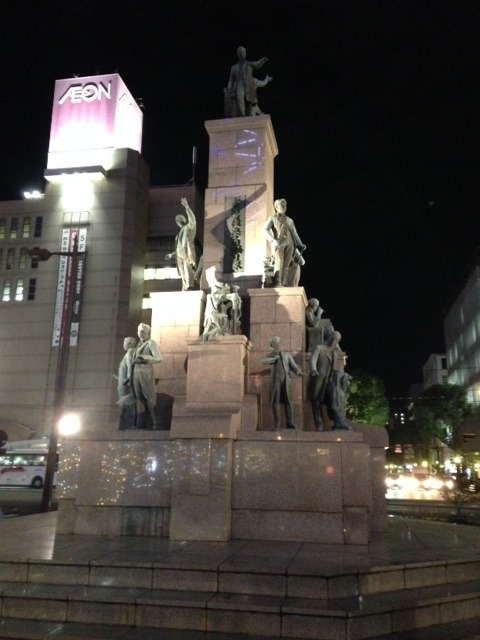
These students also attended a World Fair in Paris or some of them not quite sure if all of them attended it was after their trips abroad. They also circumvented the travel restriction for Japanese by registering not as from Japan but representing the Satsuma domain as an independent delegation. I may not be 100% accurate with all of this info, since I couldn’t take photos in the museums, yet it gives you a good idea of what the Satsuma domain was doing to improve and modernize.
There is also a strong connection between Satsuma and Hokkaido - many of the leaders during the Meiji era that pushed industrialization were from Satsuma and used Hokkaido as the source for raw materials to power the factories in the south. Plus, many people from the region moved to Hokkaido to work either as the frontier soldiers or as laborers in the “frontier”. This has been mentioned before in regards to GK as Noda’s own great-grandfather was a frontier soldier from Kyushu (whom I’ve wondered was also a practicing Catholic based on how Noda depicts Christian theology). I recall reading this in some interviews with him translated by GK Central, but I forget which ones right now.
Another industry that grew up in the mid 1800s was the development of Satsuma cut glass (kiriko) which become more industrialized during the late Edo early Meiji period. Unfortunately, the technology was lost and in the 1980s, it was finally determined how to manufacture it again. As a result production started again and it is only produced in Kagoshima.
On the grounds of Sengan-en they have a fully operational glass works. You can watch the glass being blown, shaped, cooled, marked and cut. It was pretty neat! I thought about buying some; it was more expensive than I expected - small pieces started at about $200 USD and it only went up from there. There were gorgeous sets of two glass that sold for about $500 and it was clear they were wedding presents. It was really amazing and if I had more money, I’d be tempted to purchase some myself. My Mom did purchase a small green and blue bowl after looking at it at the glass works, and then looking at it in a Satsuma local goods store two more times before deciding to actually purchase it.
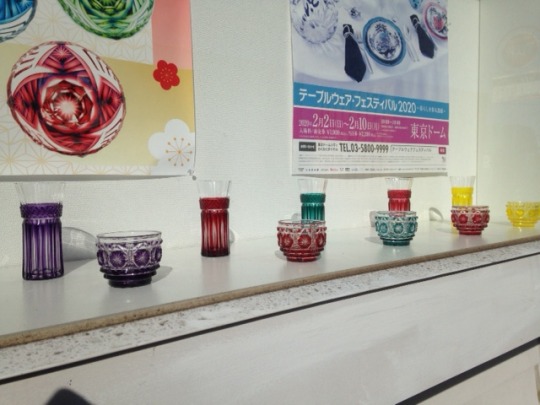
Since it was unique, the distribution of this from Satsuma helped with international relations and was considered neat by those in Europe who could purchase it. I think the best way to look at the cut glass is that it was an excellent example of a Satsuma [Japanese] product that combined with a European product, illustrating how this region was changing to adapt to modern times outside of Japan. There was also Satsuma porcelain that was made for the European market and it was very successful around the time of Golden Kamuy as an export.
To get an idea of the type of house that Koito likely grew up in, it would be something similar to, but obviously smaller than a place like Sengan-en. The house was quite large and the gardens and other buildings around it made for a place that was large and significant looking. It also had a mix of a Japanese and more Western style for some of the buildings as well as Chinese and Ryukyu influence.
This is the main gate that leads into the area where the house is in a large courtyard. It has a much more Chinese style with the bright red and slightly different roof shape. The English info said it was Chinese style, but I wonder if it wasn’t more Ryukyu since they were the domain that was essentially “controlling” *ahem* them at the time.

This was the inner courtyard of the house. The house had been added onto over time from the 19th into the 20th century as well as some parts being removed like household secretary rooms and other stuff now outdated.
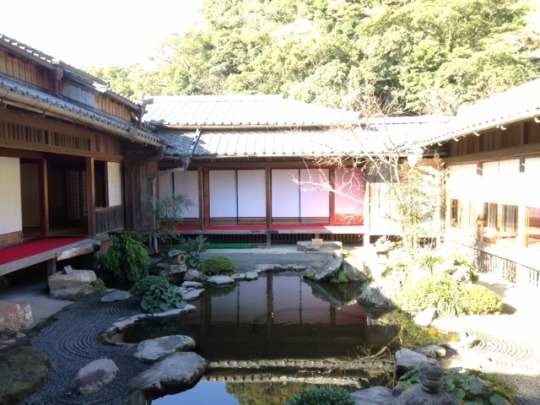
The Shimazu family often hosted foreign dignitaries including Tsar Nicholas II (obviously before the Russo-Japanese war)!!! There were two large vases that were gifted to the family from Nicholas II on display in one of the rooms with lots of historical information about how the family hosted many people from around the world. Many of the people hosted here were from the UK and the Netherlands as well. If I recall correctly, the highest number of foreigners were from the UK (again, that Sastuma orange link).
This is an example of how the table would have been set for dinners for hosting European guests. The vast majority of the house was still completely Japanese in style in regards to the furniture, but this dining room and another (sitting? living) room had Western style furniture. The table setting appears to have Dutch plates, Western cutlery and several types of glasses including the local Satsuma cut glass produced in the local glass works. I believe my Dutch Canadian friend has the exact same plates that you can still buy today.

I took tons of photos of the grounds which featured many tropical and subtropical plants like these cycads and palm tree. You can see some of the buildings in the background and a Western style lamp post as well.

I have no idea what this building originally was, but it was clearly based on a European inspired design and a part of the estate. It is now a Starbucks and I didn’t investigate it any further.

The style of this house makes me think of the house that Koito lived in when his family moved from Kagoshima to Hakodate. There was also a “foreign engineer” house close by where English engineers lived and helped with the development of Kagoshima. I was a moron and forgot to visit it . . . but I did see it from the road.
https://whc.unesco.org/en/documents/136169
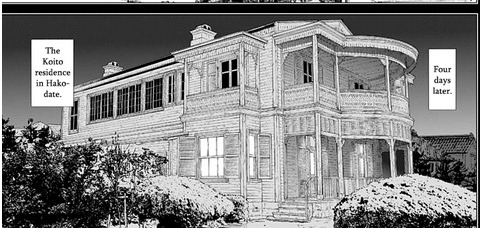
I would say it is a toss up if Koito lived in a modern Japanese style house/estate like Sengan-en in Kagoshima or in a more modern house like the white one on the Sengan-en estate or the “Hakodate” house above.
What you get from visiting a place like Sengan-en is what it would have been like to be an elite from the former Satsuma Domain/Kagoshima. Including your personal doctor inspecting your poo everyday . . . These [predominately] men in power were hosting and having dinners with foreigners and were very passionate about the modernization of Japan in the face of the world colonial powers getting closer to them.
This connects with the fact that Koito owns the motorbike. Now it is unclear if this came from a Japanese individual in France or directly from a French person. When I did my chapter meta, I assumed it came directly from a French person but upon reading it again, the translation is unclear what the nationality of the acquaintance is, just a person in France not actually French. What it does show is that Koito’s father is connected internationally as a member of the Meiji elite many of whom came from Satsuma due to their pro-Western technology slant so that the could expel the barbarians [and freely make use of their science and technology for Japan]. I would guess the fact that Koito Sr. served the Meiji government well, indicated he was more in favor of modernization and less about a more hyper samurai opinion to maintain the old ways during modernization (e.g. Saigo Takamori).
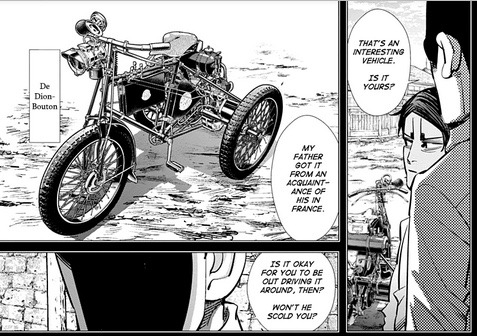
Another thing is how the men in power from places like Satsuma linked themselves to the former shogunate through marriage and likely married women from the “losing” side to further integrate themselves into the power base in Tokyo. You wouldn’t want to completely cut out the losing side completely. Instead, with those that likely switched sides sooner integrate with them as you had the “in” to the old government which would become key for the new government fit into for stability. Completely cutting off members of the former government would lead to future issues since many of those individuals were still clearly wealthy and had more local connections in Tokyo than someone from Kyushu may have had.
Recall, when Hijikata fights Inodou, he mentions Enomoto Takeaki in chapter 135 as noted by EHS scans. He was a member of the Shogunate government who was key in founding the Imperial Navy that Koito’s father is a member of.
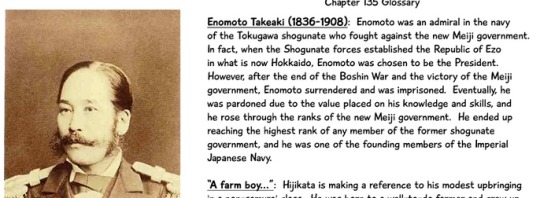
Another thing I learned at Sengan-en is that one of the Shimazu daughters married the last shogun in part to politically sway the shogun to transition and make way for the new Meiji government. This again shows that those from places in the south were positioning individuals to allow them to create a new government as easily as possible.
Since Koito’s father is a tall, darker complexion Satsuma man, as Koito is, his flashback highlights how different his mother looks. She’s very light in complexion and Koito mentions on his older brother looked like a Sakurajima daikon with very light skin tone.
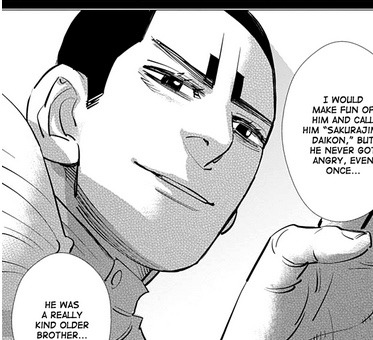
Koito and his brother got their eye brows from their mother, yet he did not get her lighter skin tone, so on top of his Satsuma accent, other characters can tell that he’s from Kagoshima (or at least someplace in Kyushu).

I find it interesting that Koito’s mother is wearing a kimono in a house that is completely Western in decor and she almost looks uncomfortable in her surroundings. I can’t help but think it would be more socially appropriate for Koito’s mother Yuki, to also adopt Western style dress to fit with her position and role as the wife of an important member of the military and modern society. It is clear they are hosting foreigners in some fashion. When I was visiting Sengan-en, there were many photos of women wearing Western style dress ~1900, so many of them also adopted their fashion like their male family and friends did. Yet, instead, she seems out of place as though she didn’t grow up with this style (somewhere around Tokyo perhaps) and is unsure how to fit within it. Koito in contrast since his introduction at 14, is shown wearing full Western style dress and he’s sporting a much more Western style hairstyle than any other character had as a kid. Does he have an English style haircut?
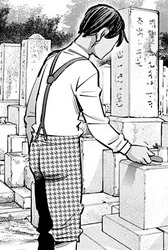
I always get the feeling that Koito being raised in a more Western learning environment as a child in Kagoshima and being surrounded by a greater mix of people and seeing more differences he is just more comfortable in his role as a future military kid. He may not even realize it, but compared to many of the other GK cast members he’s both sheltered and open to things with his education. He has been spoiled and it shows in his dependence on Tsukishima, yet at the same time, he’s one of the most educated members of the group and has to be multilingual.
His bratty behavior which does not result in punishment from his father is also interesting as I sometimes wonder if his father was hoping he’d out grow things or come to his senses. It sounds like a more Western way to parent, but it is still the early 1900s so I could totally be off the mark here. Plus, in Koito’s flashback he seems to imply his brother’s death resulted in his father detaching himself from Koito, perhaps out of fear that if he did what his older brother did, he too would die? I think this makes sense with how Koito Sr. does rescue him and also when he tells Koito he’s glad he’s alright post-Karafuto-Sugimoto stabbing.
Some more general observations from walking around Kagoshima. People there seemed more relaxed, I observed people jaywalking, crossing a street against a “no crossing” sign and cars honking at each other! The feel is completely different than very stoic cities like Tokyo or Kyoto. Not surprisingly, there were also people with complexions that were darker like Koito and his father as well in Kagoshima and Miyazaki prefectures, so he really is a character based in reality. Not that I doubted Noda, but he really does try to make his characters as realistic as possible. I’m sure with current beauty standards people are more aware of this and try not to tan as much as they would have in the past, but there were quite a few people who just had a different skin tone and it was January, so not a lot of long days of sunlight.
The other aspect of Kagoshima is its relationship with the volcano, Sakurajima. The daikon and komikan are both grown on the slopes of the volcano due to the soil and are important local products. The volcano dominates the region as it is visible from pretty much anywhere in the city. It is also a very active volcano, with ash coming out almost continuously and with multiple eruptions per day. When you walk around the city there is ash everywhere on the ground, under bushes and in corners. The city has active street cleaners/sweepers to remove the ash from the roads.
Here is my first good view of the volcano taken around 5pm from the Dolphin Port area. You can see a little bit of the ash coming out of the right side of the southern peak.

Here is a view of Sakurajima from Sengan-en. The ash is mixed with the light clouds but again it is moving to the left (a southern direction). If you look closely you can see the electric rail line above the wall for the JR Kyushu local lines.

This is the best scenic shot taken from Shiroyama, a view point in a public park again around 5pm. Unfortunately, the trees and bushes obscured part of my view to include the northern part of Kinko Bay (to the left). Yes, that is ash from the volcano drifting off to the right.
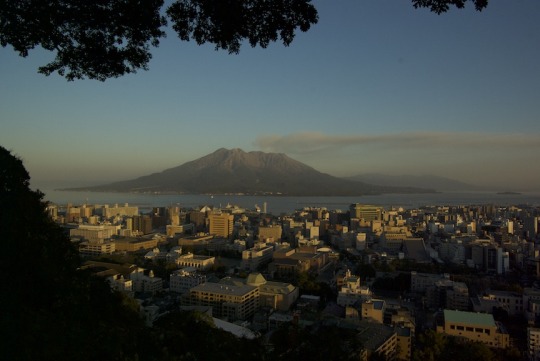
A similar shot from the manga is here in chapter 197.
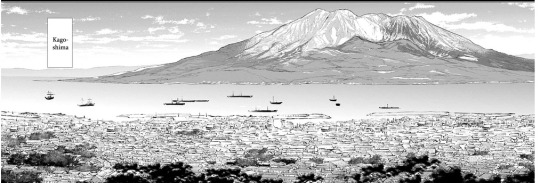
Here is a bit more zoomed in photo showing how the city is right across from the volcano.
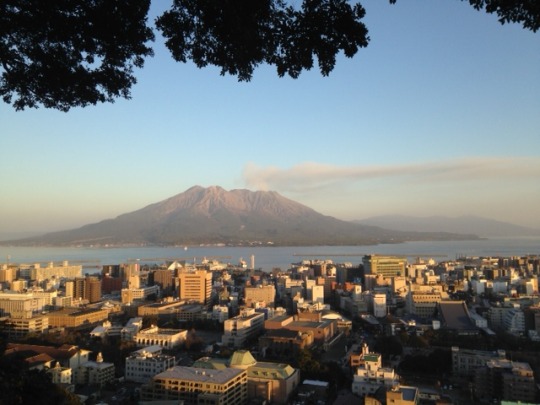
I was able to take the ferry across to the volcano a quick 15 minute ride. The volcano was a separate island until an eruption in 1914. Hence the name of Sakurajima even though it really isn’t an island (-jima) anymore. Interestingly, during Koito’s time (pre-1914), the volcano was dormant for most of the previous century but since they were growing the crops that thrived on the volcanic soil they were more than aware of the power of the volcano.
Here is a picture of one of the four ferries in action. These had space for regular passengers as well as cars for the lower decks.
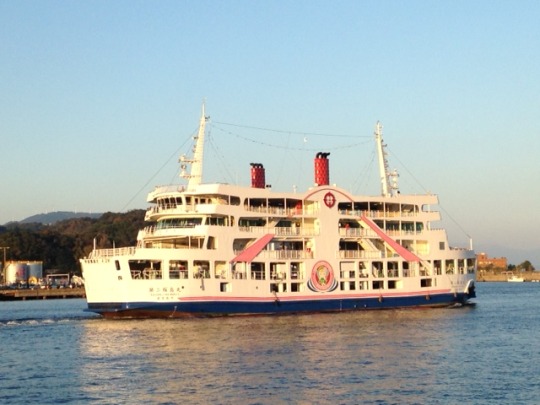
The entire bay and surrounding area are a large caldera. I’m failing to explain this well, but the volcano really is a major presence in the area. Kind of like how you feel when you see Mt. Fuji, Niagara Falls, the Grand Canyon etc but more personal. This is from the lookout point on Sakurajima. The volcano rises up in the background.

From the viewpoint you can look back across the bay towards Kagoshima. It was cloudy and overcast the day I visited the volcano; this is looking towards where Sengan-en is.
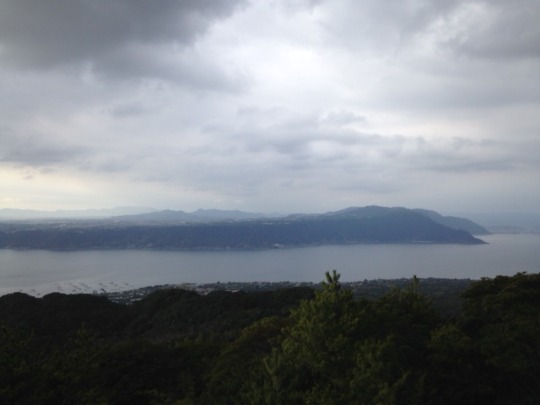
This is looking south towards the base of the bay eventually leading toward the ocean (it curves towards the left for the ocean).
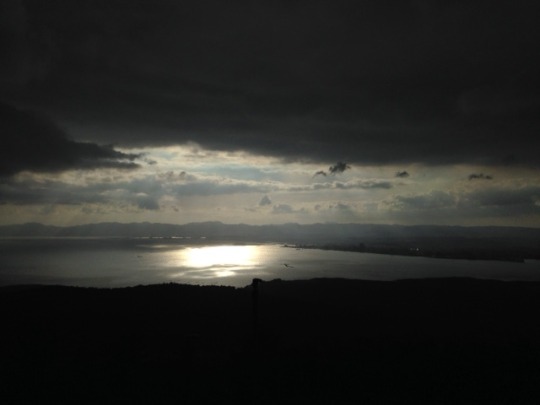
As we took the ferry back to Kagoshima port, the sunset highlighted the cloud and ash covered top of Sakurajima.
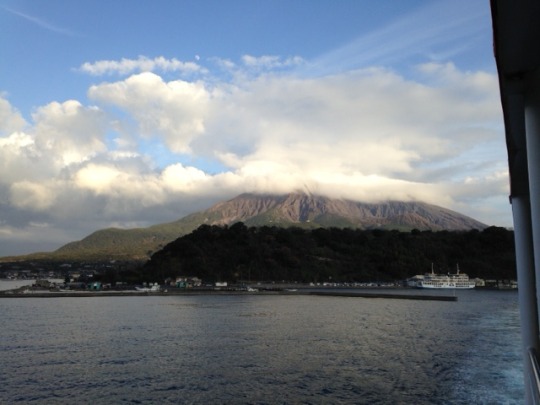
What I’m really trying to highlight is how Sakurajima is a fundamental part of the Kagoshima area (it is part of the city) and it has influenced this area for a long time.
Unrelated, there are lots of stray cats on Sakurajima that are friendly and like to be petted. About 50% of the population all have these stubby tails as I got this shot of an orange and black cat with the volcano in the background. I did pet this cat. My brother also petted some of the cats too.

With all of the things that I learned in my visit to Kagoshima, I will use them to try to understand parts of Koito’s character and what may happen in the future for his character.
1.) Koito as a Satsuma elite -
It became very clear to me visiting museums and walking around the city that Kagoshima is a very European influenced city and prized including a Western education. My Mom also remarked that it appeared much more diverse in architecture and more Western looking (and she had no idea that I was observing this for my meta).
It is no surprise that Koito would have been a well educated young man and also interacting with foreign visitors on a regular basis. Before his older brother died he sounds like he was energetic but likely much more well behaved than his 14-16 year old self. Once he realized he wanted to go into the Army after his “rescue” by Tsurumi, he was an excellent student and excelled at his courses and passed his exams to enter the military college.
He trained in Jigen-ryu and based on his skill he has shown so far in his fight with Sugimoto on the airship and when he attacked the random Russian prisoner. Even if he was a wild child, he must have kept up the practice as demonstrated when he encounters Tsurumi in Kagoshima. He states that he’s the son of an important man, so he’s of course using that to his advantage and he’s upset. (special thanks to @goldenkamuyhunting for letting me use the new volume 20 pages!).
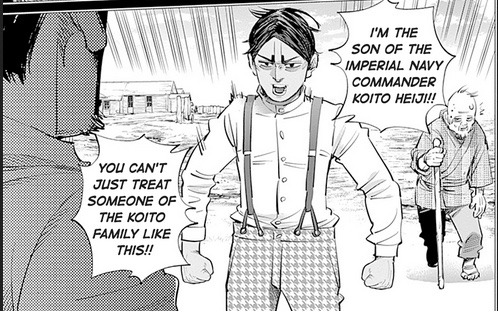
He then challenges Tsurumi with the old man’s cane instead of a sword. Sure he loses for all sorts of reasons - using what appears to be a lightweight cane, letting himself get overly emotional . . . the fact it is Tsurumi.
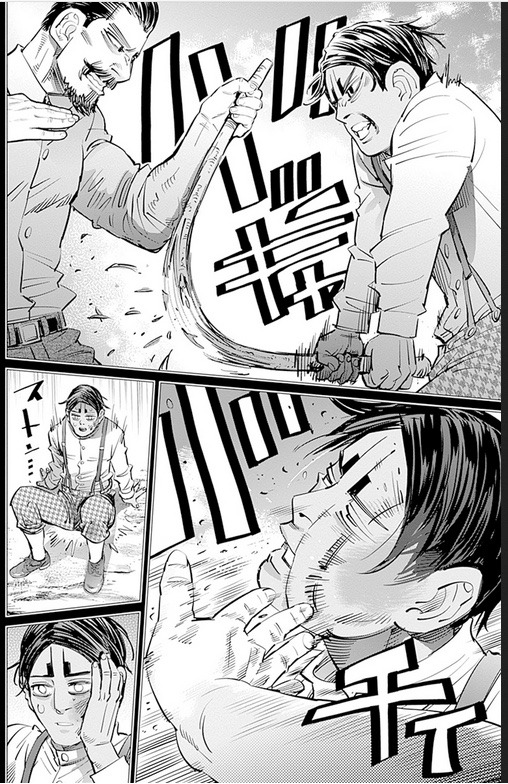
But after Tsurumi slaps him and leaves him in shock both failing to defeat him and using jigen-ryu, Tsurumi flatters him on his form. I take this to imply even if he is rebelling, skipping school and whatnot, he’s still practicing his jigen-ryu.
Previously, many of us avid readers of the series wanted Sofia and Koito to meet in Karafuto as we wondered if he was fluent in French as required for a military officer. However, after leaning that many people from Satsuma were aligned with the UK and also interacted with the USA around this time, I’m wondering if Koito can speak English instead. Tsurumi purchased weapons from a foreign arms dealer, Mr. Thomas (chapter 31). It is pretty damn obvious with the name of Thomas this man is an Anglophone. Though he’s based on a Scottish man, so he’d have a unique accent.
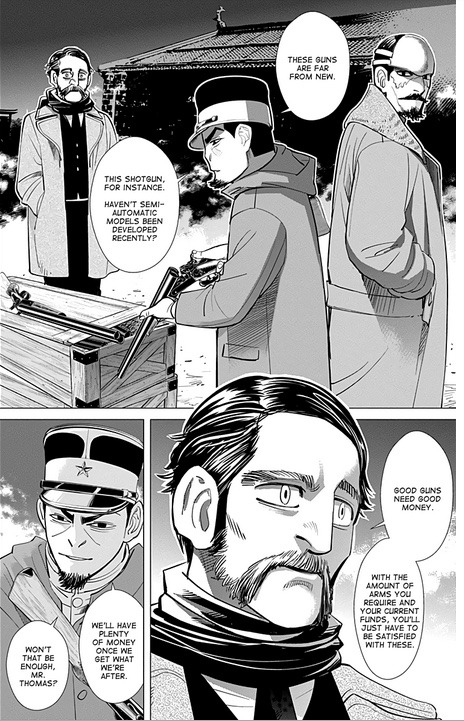
It is clear in this chapter that only Tsurumi and Tsukishima are meeting with Mr. Thomas in an isolated location. Based on the fact that Tsukishima and Tsurumi are both speaking with him, I would assume that they are speaking Japanese. This does not rule out that they also corresponded with him in English as well. I wonder if Mr. Thomas will reappear in the manga again as an arms dealer. Will the Anglo-Japanese relations of that time period come into play?
@goldenkamuyhunting has previous written about the fact that Mr. Thomas is likely based on Thomas Blake Glover a very successful merchant and business man in Japan who started out in Nagasaki. He also was one of the allies of the Satsuma domain families and involved in sending the students abroad to the UK.
Since Glover was more than willing to work with those in the Satsuma and Choshu domains, eventually leading to the overthrow of the shogunate government, perhaps we are to read that he’d be okay with another rebel faction in Hokkaido? Or since he became successful through relations in Kyushu does Koito Sr. know him?
2.) Koito is a citrus fruit.
This is a bit of an unusual angle, but I’m going to follow Noda’s lead here. Koito refers to his older brother as a Sakurajima daikon. It is clear that was his teasing nickname for his older brother, but it also something that he associates with his brother as a way to remember him now that he is gone.
If Koito Heinojyou is a large white daikon, than there are two options for Koito Otonoshin; sweet potato or mikan/satsuma orange. Sweet potatoes are more of a commoner food (alternative to rice) so a mikan makes more sense. I’m sure rich people still ate fancy sweet potato things, but likely in 1900 not all commoners could eat all the citrus grown in the area. Fresh fruit is always expensive.
Citrus fruits are brightly colored and energetic. All of the ones in Kyushu are various shades of orange and yellow. The mikans are a rich orange and are sweet and tangy. The aren’t a root vegetable like daikon or sweet potatoes, they grown on trees. Citrus need lots of care and attention to thrive. Citrus can only grow in warm climates and until modern industrial agriculture are in coastal regions (we are not discussing the central valley in California for various reasons). They also have fragrant flowers and are associated with people who are fresh, exciting, colorful and energetic. When you eat any type of citrus; lemon, lime, grapefruit, pomelo, yuzu, mandarin, mikan, clementine . . . etc no one would describe the flavor as weak, dull, or subtle. They are sweet, tangy, sour, bitter and aromatic as well. There is a lot of emotion and depth in citrus.
He’s charming and canonically an attractive male character. Sei Kobiyama has tweeted about this when the Vol 16 cover came out and the red eyeliner is linked to him be an attractive young man.


He’s got upper class manners and enjoys his Russian tea time.
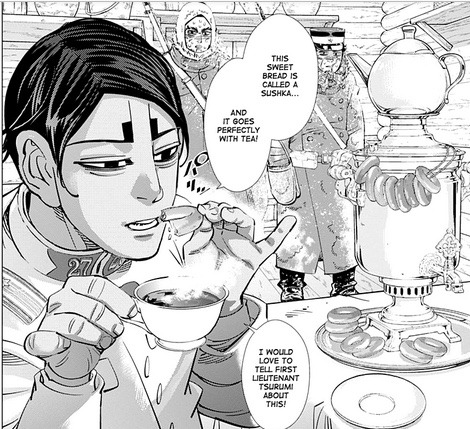
Sei Kobiyama also noted that even when he tries to be angry and mean he doesn’t swear like the rest of the cast.

His deadpan upon his realization that he set Sugimoto up with his sabre blade.

The look of absolute horror that he may rip his skin off when trying to remove the cold hammer. I feel sorry with the volume edit where it is clear Sugimoto chased after him and pissed on him . . . why didn’t anyone suggest pouring some hot tea on his hand?
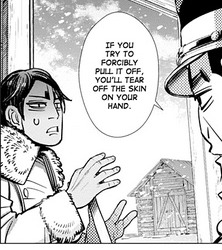
All of these aspects of citrus apply to Koito. His brother was a solid first son, well behaved and stable just like the large Sakurajima daikon. He is a native of the area, but his mother’s background is reflected in him as well. When Koito is rescued by his father and Tsurumi, we learn that Koito Heiji is also a much more dramatic and energetic man rushing in to save his son. These are passionate men who when at their best radiate this energy and warmth.
Koito’s older brother is a boring old root vegetable while he and his father are clearly sassy citrus, needing their sunshine and pruning etc etc. They may be capable men but face it, Koito Sr. spent too much time hiding his feelings and Koito is a very pampered guy who is very concerned about his appearance. Sure, he wanted Tsukishima to get his hand mirror so they could locate Vasily . . . but . . .

. . . but not without fixing his hair before looking!
And one of my absolute favorite jokes in the entire manga. Yes, I think Noda watched the classic comedy/parody “Spaceballs” for inspiration as a Princess has a ton of luggage that she insists on taking with her to the annoyance of commoners who rescued her.
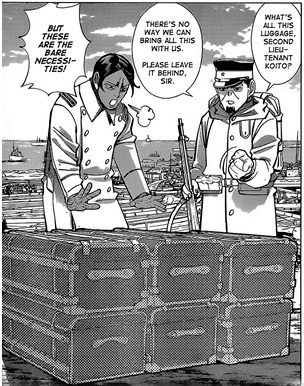
I predict 50% of this contains personal care products for him. He’s so far north he’ll need to moisturize, and his hairstyle likely requires all sorts of products to keep it in such tip top condition. Okay, I’m jesting a bit, but I’m sure a lot of his stuff is for him to pamper himself.
Maybe as things change he’ll become a sweet potato? His hair color is pretty much the same color as one of the local Satsuma varieties - I kind of want to send Noda a message if Koito’s hair color is sweet potato colored. According to Sei Kobiyama he’s supposed have crow feather colored hair, which is considered very beautiful, but I see sweet potato.
3.) Koito comes from a region where people have recently questioned authority.
The most famous individual who helped shape Meiji era Japan and was from Kagoshima was Saigo Takamori. Tsurumi (as Hasegawa) tells Wilk, Kiro and Sofia about the 3 main founders of modern Japan. Sofia was compared to Saigo and he is from Kagoshima. Despite the fact that he lead to the change in government, he found himself in disagreement with the Meiji government and eventually returned to Kyushu to lead dissatisfied samurai of the region in a rebellion against the government.

It was clear visiting Kagoshima that he’s still a very famous and respected man, with many of the sites that you can visit are related to him. There is a statue of him along the art & culture road and he’s found everywhere; in shops, on o-miyage, products. If you see his statue in Tokyo’s Ueno Park, he’s portrayed in a less positive fashion (he’s got a bit of a beer gut as we’d say in English).
What is interesting is that Saigo worked in the Meiji government for some time. He didn’t just immediately fight against those he should be serving. Instead, he worked as a part of the government for some time and his somewhat both logical yet flawed ideas attempted to deal with the rapid social and societal change that the Meiji government was forcing upon everyone. He however, seemed more focused on the military than industrializing which would be counter to what he would have ultimately wanted. I’d say the soft power of the Shimazu family was much more forward thinking as they wanted to pursue industrialization.
Koito has spent a long time of his “focused” life trying to serve Tsurumi and prove to his father that he will be a good soldier. With the flashback in chapters 197-200, and his confrontation with Tsukishima in 210, he almost had a nervous breakdown.

He started to put things together and when Tsukishima threatened him and told him how Ogata killed Hanazawa he just was in complete shock. He was screaming in a non-Satsuma accent as he just did his best to behave how Tsukishima would anticipate he would behave.
I think in part when he got stabbed by Sugimoto when Asirpa escapes is in part due to the fact that he was still in shock. He lacked the usual energy and passion and overall “Koito-ness” that he’s shown in many other chase scenes. I honestly felt Koito was going through the motions when pursuing Asirpa and Sugimoto. Based on his mistake of approaching Sugimoto, I really think this adds to how he wasn’t quite with it during that chapter. He didn’t know what to think or do so he just went with the flow and relied on his training to cover up the fact that he clearly was a mess inside learning about Tsurumi. Even though he’s quite passionate and emotional at times he clearly does hold some of his emotions in and indicated by his distance/sulking post Ogata escape.
He stubbornly tries to get Tsukishima to keep pursuing Sugimoto as he weakly tries to waive him off. He’s trying his best to be a tough Satsuma Hayato (which I think is what he thinks he should be doing/acting as), and he made a mistake fighting Sugimoto even though he did the best he could do. He’s likely feeling very ashamed and still trying to determine what is going on with Tsurumi anyways. I also agree with Sei Kobiyama here that even though he’s a Satsuma Hayato, he’s too “nice” to really be one. I just keep coming back to him and Enonoka.

When we finally learn about his health he tells his father that he’s pitiful. Is he pitiful since he tried to stop Sugimoto? That he realized he’s been used by Tsurumi since he was 14? That Ogata gave him enough information that he sees what Tsurumi is doing isn’t for the benefit of the military and instead it is for Tsurumi’s own personal goals? The good thing about Koito being injured is it will give him a lot of time to think and rest. I really think him cornering Asirpa less than 12 hours after he learned part of the truth from Tsukishima was not a good thing for him.
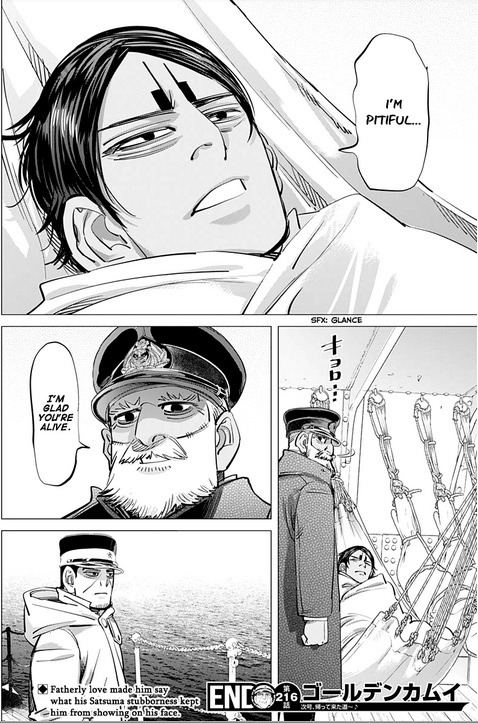
That pained look on his face as his father looks away before telling him that he’s glad that he’s okay . . . and thankfully when Inkarmat finally reappears, she’s giving him his daily fortune as well as Tsukishima. His blush likely indicates he’s got some sort of crush on Inkarmat. He’s an extroverted guy, so he’d likely get along with someone like her. Even though he doesn’t interact with many females, I get the feeling that he relates to them better than men. I just think of how he was so sweet and respectful of Enonoka and he clearly enjoys Inkarmat’s company. I get the feeling that Inkarmat in canon is supposed to be a very attractive woman and we know she is both charismatic and independent.

Koito has kept himself going by trying to follow the military order and establishment up to this point. For him to question the system and go against Tsurumi, he will have to shatter his entire view of the military and how it operates.
I think Koito will want to seek out the truth as to what is really happening with Tsurumi. We know when he focuses on something he’s successful - just dealing with Tsurumi is going to be very difficult for him.
Thanks to @goldenkamuyhunting, I was able to see this change to volume 20 chapter 200. Koito is able to help himself up by himself from the blows that Ogata dealt to him. Battered and bruised he is able to exit the small hospital and we see a determined yet rough looking Koito. He gives the feeling of a man who wanted to catch Ogata to ask him more. I think Koito is thinking “What do you mean about the Manchuria Railway Ogata? What happened to Hanazawa? Why do you know the word a Russian kidnapper told me?” . . .

We later learn in chapter 210 that Ogata mentioned the Mantetsu (Manchuria Railway) so that Koito would link Hanazawa’s death to Tsurumi’s plans. I think Koito wanted to know what Ogata was referring to. He’s also likely had to rethink his opinion of Ogata based on chapters 200 and 210. He is an officer in the military, he’s an educated elite and he’s putting together big picture concepts that Ogata is dropping him hints about. I think he’s got the potential to be a clever character as well if he can gain confidence in himself. In the revised flashback with Tsurumi when he was 14, he was confidence using his father’s name. He needs to be 100% confident in himself. I hope he can get there!
Really the biggest determent to Koito’s character is how his bratty rich kid attitude prevents him from connecting with others. Time and time again he is not nice to others since he can get away with it. This is the aspect of Koito’s personality that I like the least. The only time that I liked it, is the fact that he is the only character to call out Sugimoto’s bullying and to go head to head with him. I think the rest of the characters may want to stand up to Sugimoto, but they can’t since they aren’t as privileged so they don’t know if they can. Koito however, just uses his baseline sense that he can push back at Sugimoto since “How dare he?” treat him poorly. His reasoning is a bit flawed but his response is what I would like to see others do as well. He really is just like Ogata in that regard, both of them have personalities that developed as a result of their background that makes it hard for others to connect with them. Ogata since he’s so distant refusing to connect with others and being too sarcastic for a lowly superior private and Koito since he’s just used to others obeying him as a result of his family and privilege.
So to stick with the local food analogy - I want Koito to go from being a citrus fruit to a sweet potato. Still important but much more humble.
Another Kagoshima analogy would be that Koito is like Sakurajima. His true potential and skills are dormant, but like the volcano does in his future, 1914, he reaches his full potential and is an amazing leader and force within the country.
Well that is all for my Kagoshima-Koito post. I hope you’ve enjoyed it. I felt that visiting Koito’s hometown gave me a better perspective on him and where he came from. This is something I wouldn’t have know if I hadn’t visited it! I had a great time visiting and learning about Koito, so if you have a chance to visit do so! If people are more interested, I could do a more detailed Koito tourism post in the future.
#golden kamuy#golden kamuy meta#koito otonoshin#koito heiji#koito yuki#koito heinojou#kagoshima#satsuma#satsuma hayato#sakurajima#tsurumi tokushirou#tsukishima hajime
39 notes
·
View notes
Text
Continuing from this last thing... I realize now, already, that this is going to turn into a whole obnoxious congaline of posts.... but oh well, I'm in it now.
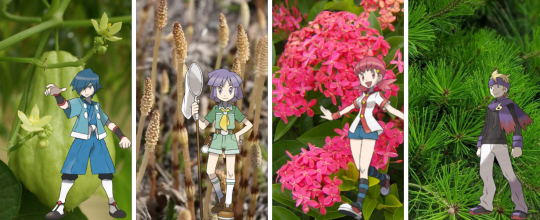
Falkner's name is Hayato, which is technically just hayato[隼人]: "Falcon man/person," an indigenous people of kyushu prior to Yamato conquest, but also taken from hayatori[隼人瓜], what's called a "Chayote" or "Merleton." The Japanese name is literally "Falcon+People+Melon."
Bugsy's name is Tsukushi from tsukushi[土筆], the Japanese name for "Horsetail"/"Snake grass" but written in Japanese as "Ground+(writing)Brush."
Whitney's name is Akane, from akane[茜], a specific species of Japanese Madder: Rubia argyi, aka "Red Madder," hence her hair color.
Morty's name is Matsuba, taken from matsuba[松葉]: "Pine needle," specifically and not just matsu[松]: "pine tree." Oddly he shares a theme with Omatsu(aka Charm), Agatha and Bertha's ancestor, which they don't. (There's more to Omatsu's name but I'll get to it later.)

Chuck's Japanese name is Shijima, seemingly taken from the Haworthia shijima, a species of Zebra plant. Makes sense to name a tough guy after a succulent as they're both known to be resilient under harsh conditions.
Jasmine's name is Mikan from mikan[蜜柑], the Satsuma Mandarin, hence her little orange ball hair ties.
Pryce's name is Yanagi like yanagi[柳]: "willow." The fuzzy white flowers of the pussywillow seem appropriate imagery for a whitehaired old man.
Clair's name is Ibuki, same ibuki[伊吹] as the "Chinese Juniper" tree. Somehow i thought she'd have a name more closely related to Wataru's(Lance). I feel like her general color palette as well as the town name Fusube City, evoking fusube-iro[燻べ色]: "Smoke color"(a shade of black) point specifically to the dark, waxy, blue-ish color of Juniper berries. She shares a general theme with Nezu(Piers) in Galar.
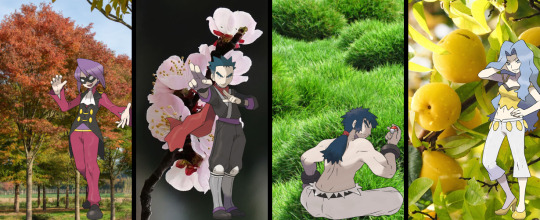
Will's name is Itsuki, referencing Tsuki[槻], the "Japanese Zelkova" tree, aka the "Japanese Elm." Its flowers are rather unremarkable but they do change into a pretty shade of red in the autumn. Not sure I really see any parallels with him and his design tho...
Koga we've tackled before*
Siba's in the same boat as above*
Karen is just a lazy localization of the Japanese Karin[花梨], which is the Japanese name of both the "Burmese Rosewood" as well as a few different species of Quince tree. (I went with the rosewood for the image on second thought her bauble belt thing is definitely a reference to the shape and color of the Quince fruit, so i changed it) Her ancestor Sazanka's name references sazanka[山茶花] the Camellia sasanqua, the japanese camellia. It doesn't really relate to Karin's name at all, but curiously it does share a theme with Diamond Warden Melli's name, Tsubaki[椿]: "camellia."
and as stated previously, champs will get their own post, but obvious Lance was also covered in the *previous post as well.
[Kanto] [Johto] [Hoenn] [Sinnoh] [Unova] [Kalos] [Alola] [Galar] [Hisui] [Champs] [Paldea] [Paldea2] [Paldea3] [Teams] [Misc.]
#pokemon#johto#falkner#bugsy#whitney#morty#chuck#jasmine#pryce#clair#will#bruno#koga#karen#lance#pokemeta i guess
56 notes
·
View notes
Text
Timeline
Legend
Shinsengumi
Okita & family
Hijikata & family
Kondo & family
Shogunate
Satsuma, Choshuu, Tosa
Other
Most dates are based on Western calendar.
Dates in brackets [ ] are based on lunar calendar
1834
November 9 [October 9]:
Kondo Isami is born
1835
Hijikata’s father Yoshiatsu (Hayato) dies
May 31 [May 5]:
Hijikata Toshizo is born
1838
Hijikata’s sister Shuu dies
1840
Hijikata’s mother Etsu dies
1842 (or 1844)
July 8? [June 1]:
Okita Souji is born
1845
Okita’s father Katsujiro dies
Hijikata's brief apprenticeship at the kimono shop Ito-Gofukuten (now Matsuzakaya)
Hijikata plants arrow bamboo
1846
[June]:
Tama River flooding
Okita Mitsu marries Okita Rintaro
1849
December 8:
Kondo Isami is adopted by Kondo Shusuke
1850 (or 1852)
Spring:
Okita Souji joins the Shieikan dojo
1851
Hijikata briefly works at another branch of the kimono shop Matsuzakaya
Hijikata becomes a medicine peddler
1853
April 5:
Mitsu’s first child Yoshijiro is born
July 14:
Arrival of the Black Ships
1854
March 31:
Convention of Kanagawa (treaty between US and Japan)
1854 (or 1856)
Okita defeats the sword instructor of Lord Shirakawa
1854 - 1857
Harada Sanosuke's seppuku attempt
1857
Nagakura Shinpachi befriends Shimada Kai
1859
Hijikata formally joins the Shieikan dojo
1860
March 24 [March 3]:
Saku-Radamon Incident (Ii Naosuke is assassinated)
April 19:
Kondo marries Matsui Otsune
Yamanami joins the Shieikan dojo
1861
August 27 [October 1]:
Kondo succeeds as the fourth generation master of the of the Shieikan dojo
[November 6]:
Hijikata became seriously ill and almost died
1862
Kondo's daughter Tama is born
[Mid-July]:
Okita becomes sick with measles
October 19:
The Shogunate and Kiyokawa Hachiro form the Roshigumi
[December]:
Saito Hajime kills a hatamoto and flees to Kyoto
1863
[February 8] - April 10 [February 23]:
Roshigumi travels to Kyoto
April 19:
The Shogun Tokugawa Iemochi arrives in Kyoto
Mitsu and Rintaro move to Edo
May 11:
Okita's first kill
August 28 [July 15]:
Shinsengumi members get into a fight with sumo wrestlers in Osaka
September 30 [August 18]:
The Choshuu clan is forced out of the court by Aizu and Satsuma
[August 18]:
The Shinsengumi receives its name
October 19:
Niimi is forced to commit seppuku by Hijikata and Yamanami
October 28 or 30 [September 16 or 18]:
Serizawa assassination
1864
January 20 [December 12] (New Year's):
Yamanami gets injured by a burglar at a shop and breaks his sword
[May]:
Okita, Kondo, Harada, Nagakura, Inoue assassinate Uchiyama Hikojirou in Osaka
[Late May]:
The Shinsengumi learns that Choshuu samurai and ronin have been coming and going from the Ikedaya inn
[June 1]:
The Shinsengumi arrests two suspicious men who admit to planning to burn down Kyoto under torture
July 8 [June 5] (Eve of the Gion Festival):
Ikedaya Incident
July 8 [June 5]:
Okita faints from heatstroke and is taken to Hamasaki Medical Center
[June 10]:
Akebonotei incident
August 20:
Kinmon Incident
November 14 [October 15]:
Itou Kashitaro joins the Shinsengumi
1865
March 19 [February 22]:
Yamanami deserts the Shinsengumi
March 20 [February 23]:
Yamanami commits seppuku
[March 10]:
The Shinsengumi moves to new headquarters at Nishihonganji
July [May]:
Matsumoto Ryojun conducts a health checkup on the Shinsengumi and possibly discovers Okita's tuberculosis
1866
August 29:
The Shogun Tokugawa Iemochi dies and Yoshinobu succeeds him
October 20 [September 12]:
Sanjo notice board case
November 2 [September 26]:
Itou and Shinohara argue with Kondo and Hijikata, and threatens to leave the Shinsengumi
December 11 [November 5]:
Kyo (possibly Okita's daughter) is born
1867
January 30:
Okita cuts down Sasaki Hyogo
April [March]:
Okita coughs up blood
April 24 [March 20]:
Itou leaves the Shinsengumi to guard the imperial tomb
Okita kills Asano Karou near Katsura River who tried to join Itou
May 29 [April 26]:
Okita's lover Ishii(or Ishida) Tsune dies
July 10 [June 10]:
Kondo gets promoted to hatamoto
[June 15]:
Shinsengumi moves headquarters to Fudodo Village
[June 22]:
Takeda Kanryuusai is assassinated by Saito
[September]:
Okita becomes seriously ill
Early-November [Early-October]:
Hijikata and Inoue visit Hino
1867:
14-year-old Ichimura Tetsunosuke joins the Shinsengumi as Hijikata's page
[October]:
Inoue's 10-year-old nephew Taisuke joins the Shinsengumi as Kondo's page
November 9:
Shogun Tokugawa Yoshinobu resigns
December 6 [November 10]:
Saito leaves Itou and reports Itou's plans to Kondo
December 10:
Assasination of Sakamoto Ryoma
December 18 [November 18]:
Itou is assassinated
Todo Heisuke is killed while retreaving Itou's body
1868
January 4:
Restoration of imperial rule is officially proclaimed
January 6:
Shogun Yoshinobu heads out to Nijo Castle
January:
The Shinsengumi leaves Kyoto and go to Osaka and sets up headquarters in Fushimi
January 11 [December 18]:
Kondo gets shot in the shoulder at Fushimi road on the way back from Nijo Castle
January 19:
Fire in Edo
January 27-30 [January 3]:
Battle of Toba-Fushimi
January 28:
Inoue dies in battle
January 30 Evening:
Shogun Yoshinobu escapes from Osaka Castle to Edo along Aizu daimyos on the ship Kaiyomaru
February 4 [January 12]:
The Shinsengumi sails back to Edo on the ship Fujisanmaru
Hijikata meets frenchman Jules Brunet on the ship
[January 13]:
Yamazaki dies of battle wounds
[January 14]:
The Shinsengumi arrives in Edo
[End of January]:
The Shinsengumi sets up new headquarters in Edo
[January]:
Okita stays at Matsumoto Ryojin's clinic
March 24 [March 1]:
Kondo is appointed to the Wakatoshiyori (Junior Council) by Katsu Kaishu
March 24 [March 1]:
The Shinsengumi departs Edo for Kofu Castle, staying at Hino for a night
[March 2]:
Okita falls ill and is left behind at Hino
March 28:
The Shinsengumi receives news that Kofu Castle was taken and stays at the nearby town of Katsunuma
March 29:
Battle of Koshu-Katsunuma. The Shinsengumi retreats to Edo
April 11:
Kondo and Hijikata gather troops to depart Edo again
April 25:
The Shinsengumi sets up headquarters at Nagareyama
April 26:
Kondo is captured by Satsuma troops
April 27:
Hijikata meets with Katsu Kaishu
April 28:
A letter from Katsu Kaishu arrives to request a pardon on Kondo
April 30:
Kondo is declared guilty for the assassination of Sakamoto Ryoma in a trial
[April 11]:
Evacuation of Edo Castle
May [April 14]:
Battle of Utsunomiya Castle, Hijikata injures his leg and rests in Aizu for 3 months
May 17 [April 25]:
Kondo is executed by beheading
June [April 25]:
Saito fights in the Battle of Shirakawa
May 20:
Kondo's nephew Miyagawa Yugoro buries Kondo's headless body, Kondo's head is piked in Kyoto
July 19 [May 30]:
Okita dies from tuberculosis at Sentagaya, Edo
October [August 21]:
Battle of Bonari Pass
October [August 21]:
Hijikata retreats from Aizu and part ways with Saito
[October 12]:
Hijikata and Tetsunosuke leaves for Ezo on the ship Oemaru from Orinohama, Sendai
December 9 [October 26]:
Hijikata and Tetsunosuke arrives at Hakodate, Ezo
13 notes
·
View notes
Text
Hideyoshi’s death - Sekigahara - chronology
This has been in my drafts for a long time and it’s a bit incomplete towards the end, but... I’m not sure if I’ll be able to answer any additional questions, these are facts (plus some rumours from secondary sources), it’s up to you to interpret them as you like.
1598
18. 8. Toyotomi Hideyoshi died | (Ishida Mitsunari informed Ieyasu that Hideyoshi died) | Tokugawa Hidetada returned to Edo
(Hideyoshi is still considered alive
some form of tension between Ieyasu and go-bugyō was apparent)
25. 8. go-bugyō issued a letter about peace with Korea
28. 8. an order to withdraw from Korea was issued by go-tairō (without Uesugi Kagekatsu’s signature) informing that Mōri Hidemoto, Asano Nagamasa and Ishida Mitsunari were being sent to Hakata to deal with it | Mōri Terumoto made an oath with Mashita Nagamori, Ishida Mitsunari, Maeda Gen’i and Natsuka Masaie about cooperation
(Ukita Hideie was often visiting Terumoto’s mansion making friends with him)
3. 9. go-tairō and go-bugyō exchanged an oath that was forbidding them from making groups of supporters from outside the ten of them and that they will protect Hideyori
5. 9. another letter about peace with Korea is issued by 4-tairō
(Ieyasu, Terumoto and Hideie were supposed to go to Hakata, but that didn’t happened)
end of the ninth month - Ishida Mitsunari, Asano Nagamasa, Mōri Hidemoto were sent to Hakata to withdraw forces from Korea.
tenth month - Uesugi Kagekatsu arrived to Fushimi from Aizu
25. 11. Ieyasu invited Mashita Nagamori to his mansion in Fushimi
26. 11. Ieyasu invited Chōsokabe Morichika to his mansion in Fushimi
3. 12. Ieyasu invited Shinjō Naoyori to his mansion in Fushimi
6. 12. Ieyasu invited Shimazu Yoshihisa to his mansion in Fushimi
7. 12. Ieyasu invited Hosokawa Tadaoki to his mansion in Fushimi
(Katō Kiyomasa, Kuroda Nagamasa returned from Korea; sometime during the 12th month, before Shimazu and Konishi; 23. 11. they departed from Korea)
10. 12. Shimazu’s forces (Yoshihiro, Tadatsune) entered Hakata
11. 12. Konishi Yukinaga and Terazawa Hirotaka (Masanari)’s forces entered Hakata
(friction between Mitsunari, Yukinaga etc. and Kiyomasa, Asanos, Kurodas)
24. 12. Mitsunari returned to Osaka together with Shimazu Tadatsune
(everyone who returned from Korea went to Osaka)
1599
10. 1. Toyotomi Hideyori moved from Fushimi castle to Osaka castle. accompanied by go-tairō and go-bugyō (it was probably a nice show). Toshiie, following Hideyoshi’s will, stayed in Osaka as Hideyori’s guardian from then on.
(Kagekatsu returned back to Fushimi)
12. 1. Ieyasu returned back to Fushimi.
(a tentative decision to return Kobayakawa Hideaki his old fiefs was made)
(Ieyasu’s marriage arrangements with Date Masamune, Fukushima Masanori, Hachisuka Ieamasa became a problem)
18. 1. go-bugyō wrote to Date Masamune that use of guns was limited in Osaka
19. 1. 4-tairō and go-bugyō sent messengers to Ieyasu that he was going against Hideyoshi’s will
(some tension appeared, some daimyō gathered at Ieyasu’s mansion)
20. 1. all was settled without an armed conflict | several generals gathered at Mōri Terumoto’s mansion in Fushimi for discussion
24. 1. 4-tairō condemned Ieyasu for going against Hideyoshi’s will
28. 1. Ieyasu went to Osaka
29. 1. Ieyasu’s vassal Sakakibara Yasumasa entered Fushimi with an army | Ieyasu was back in Fushimi
2. 2. accompanying the official announcement of Hideyoshi’s death, the go-bugyō shaved their heads
5. 2. Hideaki’s fiefs were officially returned by go-tairō
12. 2. Ieyasu exchanged an oath with 4-tairō and go-bugyō (at least on the outside it looked like Ieyasu was the one making compromise) concerning the marriage problem
(Shimazu Yoshihisa returned from Fushimi to Kyushu; 14. 3. arrived to Satsuma)
29. 2. Toshiie visited Ieyasu in Fushimi
(reconciliation between Ieyasu and Maeda Toshinaga and Ieyasu and Ukita Hideie were made before 8. 3.)
9. 3. Shimazu Tadatsune killed Ijūin Tadamune
11. 3. Ieyasu visited sick Toshiie in Osaka
3. 3. (leap year) Maeda Toshiie died
4. 3. (leap year) Ishida Mitsunari was attacked in Osaka by Katō Kiyomasa, Fukushima Masanori, Kuroda Nagamasa, Tōdō Takatora, Hosokawa Tadaoki, Asano Yukinaga and Hachisuka Iemasa and escaped to his own wing in Fushimi castle.
5. 3. (leap year) Ieyasu wrote a letter to Katō Kiyomasa, Fukushima Masanori, Kuroda Nagamasa, Tōdō Takatora, Hosokawa Tadaoki, Asano Yukinaga and Hachisuka Iemasa
8. 3. (leap year) Kita no Mandokoro (Nene) tried to mediate (either on this day or earlier)
(Mōri Terumoto and Uesugi Kagekatsu were in Fushimi at this time. Ukita Hideie was probably in Osaka being sad his father-in-law died; he could assist Mitsunari in escaping though; Satake Yoshinobu could accompany Mitsunari from Osaka to Fushimi.
Go-bugyō were also in Fushimi (maybe except for Asano, who knows). 7 generals were asking for Mitsunari’s retirement. There were also voices for Mashita Nagamori’s retirement.
Osaka was full of people loyal to Ieyasu, so anti-Ieyasu forces wouldn’t be able to enter or exit.
Mitsunari sent Konishi Yukinaga and Terazawa Hirotaka (Masanari) to Mōri Terumoto as messangers.
Mitsunari would like to attack the enemy side with Terumoto’s help, but Ōtani Yoshitsugu didn’t think it would be a good idea,
Terumoto and Uesugi Kagekatsu tried to mediate. Kagekatsu and Ieyasu talked about marriage between their two clans, but it didn’t went through)
9. 3. (leap year) Ieyasu made his final decision and the disturbance more or less ended.
(Mitsunari’s son Hayato no kami (probably Shigeie) started to serve Hideyori. He might have also become the Ishida clan family head)
10. 3. (leap year) Mitsunari left Fushimi to be confined in Sawayama. Yūki Hideyasu was sent as his escort.
13. 3. (leap year) Ieyasu entered Fushimi castle’s Nishi no maru
19. 3. (leap year) Kuroda Nagamasa and Hachisuka Iemasa’s honour was restored.
21. 3. (leap year) Mōri Terumoto and Tokugawa Ieyasu exchanged an oath letter calling each other brothers
fourth month - Konishi Yukinaga, Tachibana Muneshige, Terazawa Hirotaka returned to Kyushu accompanying Shimazu Tadatsune, who was pardoned by 3-bugyō
(a strife between Shimazu clan and Ijūin clan, their retainers)
seventh month - more daimyō who returned from Korea were allowed to return back to their provinces
eighth month - Uesugi Kagekatsu and Naoe Kanetsugu returned to Aizu | Maeda Toshinaga returned to Kaga
18. 8. Ieyasu participated in Hideyoshi’s death anniversary ceremony at Hōkoku shrine
7. 9. Ieyasu left Fushimi castle and went to Osaka. He stayed in Ishida Mitsunari’s mansion (Ieyasu didn’t have his own mansion in Osaka)
(Terumoto’s son, age 4, went through genpuku at Osaka, got Hideyori’s “hide” and was named Hidenari)
(Ieyasu offered a congratulatory speech to Hideyori 9. 9. ?)
(rumours about a planned assassination on Ieyasu appeared sometime during this period)
13. 9. Ieyasu moved to Ishida Masazumi’s mansion (Masazumi went to Sakai)
26. 9. Kita no Mandokoro left Osaka castle’s Nishi no maru and went to live in Kyoto’s Shin (New) castle
27. 9. Ieyasu started to live in Osaka castle’s Nishi no maru
(Ōtani Yoshitsugu’s adopted son Daigakusuke (Yoshiharu) and 1 000 men sent by Ishida Mitsunari following Ieyasu’s orders blocked a way to the capital from Echizen, so Maeda Toshinaga wouldn’t be able to proceed to the capital. At the same time Katō Kiyomasa’s route to the capital was also blocked.)
tenth month - subjugation of Kaga | Asano Nagamasa lost his bugyō position and was confined in Kai | Hijikata Katsuhisa and Ōno Harunaga were also punished | Hosokawa Tadaoki, related by marriage to Maeda clan, who tried to apologize for Toshinaga, sent his son Tadatoshi to Edo as a hostage
eleventh month - Maeda Toshinaga sent his mother to Edo as a hostage
1600
first month - a rebellion in the Ukita clan occurred - Togawa Michiyasu and others (mostly important Ukita vassals) VS Nakamura Jirōbee and Hideie. Ōtani Yoshitsugu and Sakakibara Yasumasa (one of Ieyasu’s Shitennō = “Four Guardian Kings”) acted as mediators (there are many stories, though, one of them goes that Ieyasu got angry with Yasumasa for sticking his nose into other clan’s business and sent him home, so Yoshitsugu also pulled himself out.)
second month - Shimazu internal strife ended with Ijūin Tadazane’s capitulation (Ieyasu sent his vassal to act as mediator)
(Ieyasu gets reports that Kagekatsu plans a rebellion)
(Kagekatsu is asked to pay homage in the capital, but he refused. Mashita Nagamori and Ōtani Yoshitsugu were acting as mediators.)
14. 4. Naoe Kanetsugu’s letter
(the rebellion in Ukita clan was settled by Ieyasu’s intervention. Togawa Michiyasu (the one who started it) and some others became Ieyasu’s vassals. Ukita clan’s power was seriously weakened.)
(At the end of fifth month, the subjugation of Uesugi was decided. The 3-bugyō were kind of against it, because Ieyasu would be “abandoning Hideyori in Osaka” but what could they do)
(After the rebellion was settled, Hideie was staying in Fushimi)
8. 6. - 11. 6. Hideie was back in his fief (what he did after that isn’t known, it’s assumed he went back to Kamigata since Terumoto was gone and Ieyasu would soon be gone. He most likely sent Ukita Akiie (Sakazaki Naomori) to Aizu as his stand-in)
8. ~ 10. 6. Terumoto departed from Osaka to return back to Hiroshima
14. 6. Terumoto ordered Ankokuji and Hiroie to depart to Aizu | Mōri Motonari’s 33rd death anniversary, which Terumoto carried out, was held at Tōshun-ji temple (today’s Yamaguchi prefecture)
15. 6. 3-bugyō gave an order to subjugate Aizu instructing the generals to follow Ieyasu’s orders
16. 6. Ieyasu departed to subjugate Aizu. He left Osaka and entered Fushimi.
17. 6. Terumoto visited Itsukushima Shrine and in the evening/night arrived to Hiroshima castle
18. 6. Ieyasu left Fushimi and departed for Edo.
2. 7. Ieyasu entered Edo | {traditionally it’s said that on this day Mitsunari and Yoshitsugu met at Sawayama, but there are many versions as to why}
4. 7. Ankokuji Ekei left Izumo
5. 7. Kikkawa Hiroie left Izumo | Ukita Hideie visited Hōkoku shrine (shrine enshrining Hideyoshi, there are theories he did that to prepare for “raising the army”)
(on his way to Aizu Ōtani Yoshitsugu stopped at Tarui in Minō (some 30 km away from Sawayama castle) because of his illness - it comes from a secondary source)
11. 7. traditionally, this is the day when Yoshitsugu and Mitsunari rose their armies together.
(around this time Ankokuji met with Ishida Mitsunari and Ōtani Yoshitsugu at Sawayama)
12. 7. Mashita Nagamori, Natsuka Masaie, Maeda Gen’i wrote to Terumoto to come back to Osaka (Terumoto got it on the 15th) | some of those who left to Aizu returned to Kamigata | some sort of disturbance was occurring in Fushimi and Osaka | rumours about Mitsunari’s possible departure for the front reached Kamigata
(from this day onward various people were writing to Ieyasu’s side about Mitsunari and Yoshitsugu’s suspicious movements. 3-bugyō, Hiroie and Yodo-dono included)
13. 7. Ankokuji Ekei and Kikkawa Hiroie arrived to Osaka | Hiroie learned about Mitsunari and Yoshitsugu’s plan
14. 7. a messenger from Ankokuji Ekei arrived to Hiroshima asking Terumoto to come to Osaka
15. 7. Terumoto departed from Hiroshima | Terumoto wrote to Katō Kiyomasa to go to Osaka | Ieyasu’s forces holed up in Fushimi castle | some forces that departed to Aizu returned back from Ōmi | Shimazu Yoshihiro sent a letter to Uesugi Kagekatsu telling him that Mōri Terumoto, Ukita Hideie, magistrates, Konishi Yukinaga, Ōtani Yoshitsugu, Ishida Mitsunari and himself decided to join his side
17. 7. Mashita Nagamori, Natsuka Masaie, Maeda Gen’i issued 13 charges against Ieyasu | Terumoto entered Osaka | Hosokawa Gracia died
18. 7. the siege of Fushimi castle started | Ieyasu’s forces in Fushimi burned down bugyo’s mansions (or wings in the castle) | Ishida Mitsunari visited Hōkoku shrine in Kyoto
19. 7. Tokugawa Hidetada’s forces left Edo to go to Aizu
21. 7. Ieyasu’s forces left Edo to go to Aizu
24. ~ 25. 7. meeting at Oyama. Ieyasu stayed at Oyama until the beginning of the eight month.
29. 7. Mitsunari left Sawayama and participated in the siege of Fushimi
30. 7. Mitsunari entered Osaka castle.
1. 8. Fushimi castle fell | the Toyotomi generals (Fukushima, Tōdō, Ikeda, Kuroda) went west followed by Honda Tadakatsu and Ii Naomasa
5. 8. Mitsunari left Osaka and returned to Sawayama | Ieyasu returned to Edo and stayed there almost a month
9. 8. Mitsunari left Sawayama and went to Tarui in Minō.
10. 8. Mitsunari entered Ōgaki castle
23. 8. Gifu castle fell
1. 9. Ieyasu left Edo and aimed back to Kinai
7. 9. siege of Ōtsu castle started
14. 9. Ieyasu arrived to Akasaka | Mitsunari, Konishi Yukinaga, Ukita Hideie, Shimazu Yoshihiro moved from Ōgaki castle to Sekigahara/Yamanaka (or wherever the battle took place) | Fukushima Masanori and other Toyotomi generals followed
15. 9. Sekigahara | Ōtsu castle capitulated
18. 9. Sawayama castle fell
23. 9. a peace between Ieyasu and Terumoto | Ōgaki castle capitulated
25. 9. Terumoto left Osaka castle’s Nishi no maru and moved to his mansion in Settsu province where he retired (in the third part of the 10th month, he gave the clan headship to his young son Hidenari (age 5), shaved his head and took a new name Sōzui)
27. 9. Ieyasu entered Osaka castle’s Nishi no maru
6 notes
·
View notes
Note
I was rereading gk and noticed something that I completely skipped over. I forget which chapter, but Ogata called Koito, if I remember correctly, "satsuma hayato." I googled what it meant and apparently it's a tribe? Idk if I read it correctly but I just wanted to hear your thoughts on it. Do you think Koito is possible mixed? He is a lot darker than the other characters. Sorry for the random question!
Hi there!
I was confused about that too. Satsuma refers to the southern tip of Japan and Hayato refers to members of a minority group that lived in Satsuma. My understanding is that they were an active ethnic group a very long time ago, like pre-1000 CE but they are now completely integrated with the Yamato - the ethnic majority - Japanese, so people don’t identify as ethnically Hayato anymore. Unlike the Ainu people, who are still active in Japan, there isn’t any recognition of modern Hayato culture or revival efforts as they’re an extinct cultural group and have been for a long while.
Most of the information and discussion I can find about the Hayato people has to do with their phenotype (basically, their appearance) and sources say they physically resembled Pacific Islanders and Southeast Asians more than East Asians (like the Yamato people).
So in that sense it could maybe be possible that Koito is descended from actual ethnic Hayato? But once again, they were fully integrated into the Yamato ethnic group, so I don’t know if it would really be possible to make that physical distinction by the early 1900s.
It gets complicated because the phrases “Hayato” and “Satsuma Hayato” took on their own meaning in Japanese culture. The Hayato people of Satsuma were famous for being incredibly stubborn and rebellious, as well as strong fighters, so the phrase came to describe fierce warriors from the Satsuma region. It doesn’t help that “hayato” means “falcon” so it just sounds kind of cool and wound up being divorced from the ethnic aspect. It was used frequently to describe samurai who came from that region of Japan.
I honestly think that Ogata is using Satsuma Hayato in this context.
Keep in mind that the Satsuma domain covered the southernmost part of Japan’s southernmost main island, which is a tropical region, where darker/tan skin is more common. Okinawa is further south and it’s not uncommon for Okinawans to have darker skin because of their exposure to the sun.
TL;DR: I don’t really know but I’m leaning more toward no.
17 notes
·
View notes
Link
Nestled on Kyushu Island in Japan, Kagoshima is a laid-back seaside city that is also a major city in Kagoshima Prefecture.
If you are looking to indulge in a more relaxed and peaceful vacation, Kagoshima is the right place for you. Unlike the hectic Tokyo or Kyoto, the atmosphere in Kagoshima is more tranquil. But, just like every other city in Japan, Kagoshima is fully loaded with a myriad of attractions that can guarantee an elevated travel experience, from parks and shrines to museums and aquariums. Keep on reading to learn about the top things to do in Kagoshima, Japan, and enjoy.
1. Tour the iconic volcanic island of Sakurajima
Japan is known for its numerous active volcanoes and one of the most popular and active volcanoes can be found in Kagoshima. Tour the volcanic island of Sakurajima before you explore the other attractions for a beautiful start of your vacation. If you observe carefully, you can see constant volcano smokes as well as minor eruptions that happen frequently in a day. Other than observing the volcanic activities, you can also enjoy other things such as having an onsen or foot baths near the ferry terminal of Sakurajima.
2. Relax in the open-air onsen of Shiroyama Hotel Kagoshima
If you are not sure about where to say in Kagoshima, you may be interested in booking a room at this contemporary hotel Shiroyama Hotel. The hotel is famous for offering an open-air natural hot spring, also known as onsen in Japanese. While indulging in the onsen, you can marvel at the fantastic views of the sea and Sakurajima. Other than the onsen, the hotel also features a spa center in which guests can enjoy a mist sauna, a flower bath, and other massage treatments. As for your room, you will comfortably stay in a room that is equipped with modern facilities that include an LCD TV with satellite channels, a fridge, and a private bathroom.
3. Stop by the Statue of Saigo Takamori, Japan's 'last samurai'
You may be familiar with the word samurai, but you may not have the knowledge related to samurais, such as the most influential samurais the last samurai. While in Kagoshima, it would be worth it to stop by the statue of Saigo Takamori, one of the most influential Japanese samurai in the history of Japan. What is more, Saigo Takamori was also believed to be the country’s last samurai before he was banished. Make a quick stop at the statue and pay your respect before continuing with your adventure in Kagoshima.
4. Revisit Japanese technological history at Shuseikan Reverberatory Furnace
It is time for some history lesson. If you are interested in gaining some insights into Japanese technological history, you need to find your way to Shuseikan Reverberatory Furnace. The site was built with the purpose to increase the wealth of Japan through strong production during the Meiji period. During that period, the people believed that a rich country would have a strong army and a strong army meant strong defense. Thus, numerous reverberatory furnaces were produced for artillery casting. This place is also claimed to be the start of the modern Japanese manufacturing industry that has grown exponentially. From this place, you can also marvel at the views of Kagoshima Bay and Sakurajima.
5. Chill out with shaved ice desserts at Tenmonkan Mujaki
You may feel a little bit tired after visiting some of Kagoshima’s most interesting attractions and you need to chill out for some time. If you feel the need to do so, there is no better place than Tenmonkan Mujaki, which is situated right in the heart of Tenmonkan shopping district. The eatery is famous for its shaved ice desserts and people are willing to wait a long line just to have a taste of the delicious dessert. With Kagoshima condensed milk and fruit scattered on top of the ice, nothing can beat the sweetness level of this dessert.
6. Visit the adorable dolphins at Kagoshima Aquarium
Nestled along the water of Kagoshima Port, Kagoshima Aquarium is an amusing place for people of all ages. Children, teenagers, adults, and elderly people can all have fun meeting a variety of native marine animals. The most prominent feature of this aquarium is the Dolphin Pool that holds three dolphin shows per day. Enjoy watching the lovely dolphins swim freely and perform some unbelievable tricks. You will also want to visit the Kuroshio Tank, a giant tank in which fish of all sizes and species come to live together in one place. Favorite inhabitants of the tank include rays and giant whale sharks.
7. Admire fine pottery at the Satsuma Denshokan Museum
You have seen animals, you have seen statues and now it is time to see and admire fine pottery at Satsuma Denshokan Museum. Through the full display of local ceramics, you can gain insights into the history of the modern-day Kagoshima around the beginning of the Meiji era.
8. Dine on Kagoshima's famous black pork at Ajimori
Pork is something that some of us eat every day, but black pork, most of us have no idea what it tastes like. That is why since you are enjoying your travel in Kagoshima, you have the opportunity to taste the city’s famous black pork. The best restaurant to indulge in black pork is Ajimori. One of the best ways to enjoy this black pork is the shabu-shabu style where the black pork is cooked inside a pot of hot boiling water. Other than the pork, vegetables are also commonly used to be boiled in the water.
9. Take a scenic rail journey on the JR Hisatsu Line
Kyushu has a lot of beautiful scenery and one of the best ways to enjoy the overall Kyushu is by taking a rail journey. The highly recommended rail journey is the one on the JR Hisatsu line between Yatsushiro Station and Hayato Station. As the train starts its engine, you can look outside the window and have a relaxed countryside experience as you are passing through lush hills, mountains and serene waters.
10. Sample the local cuisine at Kagomma Furusato Food Village
Kagoshima boasts a lot of delicious local dishes and instead of going from one restaurant to another to sample all the dishes, it is better for you to go to a place in which you can sample a variety of Kagoshima’s local cuisine. This place is Kagomma Furusato Food Village. Having opened since 2012, the food village features around 25 food stalls that serve a selection of local dishes as well as locally brewed shochu spirits. Choose the stalls that strike your fancy and have a happy lunch.
Read also: Top 10 things to do in Kobe
From : https://wikitopx.com/travel/top-10-things-to-do-in-kagoshima-japan-705662.html
0 notes
Text
back from holiday!
I’m currently hanging out with a cup of tea and my floof after getting back from my winter break.
I will try to get some meta posted in the next day or two for the chapters.
I was able to visit, Kagoshima, Koito’s hometown on my trip, so I will have a meta post about that as well! I think visiting his hometown helped me to understand his character more.
Here is a preview of some of the lovely pictures I was able to capture.
Here is Sakurajima! From the Ferry terminal and Dolphin Port.
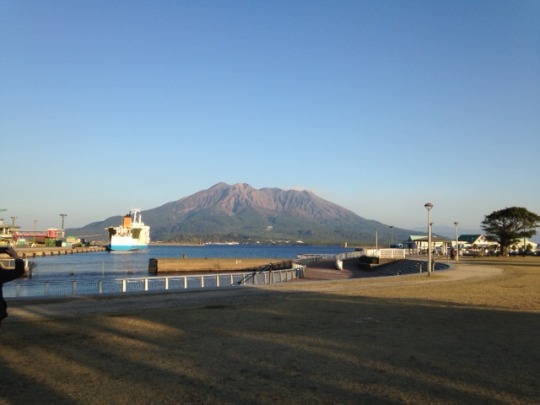
Shiroyama viewpoint looking out over Kagoshima and towards Sakurajima.
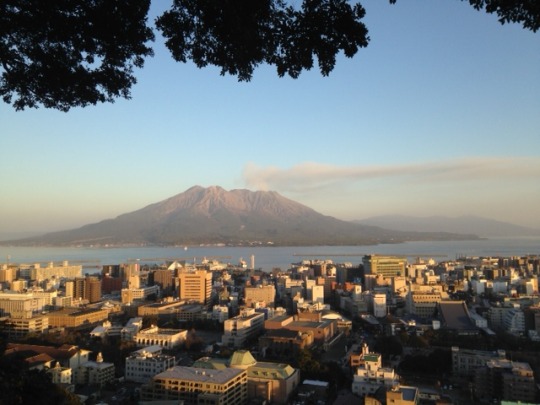
Chapter 197 flashback viewpoint panel. I think the view is from a point a little further south that I didn’t stop at.
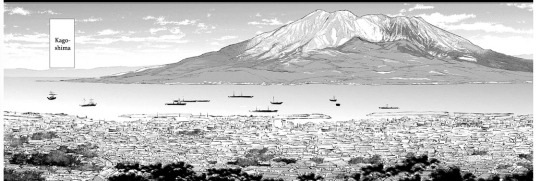
20 notes
·
View notes
Text
Hijikata Toshizou Yoshitoyo
Written by Kizu
Wednesday, 26 July 2006
Hijikata Toshizou Yoshitoyo
1835-1869
Shinsengumi Fukuchou also known as Oni Fukuchou
Born in Musashi Province, Tama in the village of Hino
Parents were wealthy farmers
Was brought up by sister’s family because his parents died early. Father before he was born and mother five years later
Met Kondou via Sato (Sato was married to his sister) and became Kondou’s student and will stay in the Shieikan starting 1859
Joins the Roshitai in 1863 with Kondou
Becomes the Fukuchou of the Shinsengumi
Said to devise the laws in the Shinsengumi, was enforcer of the official discipline within the group by instituting “internal inspections”
In 1868 commanded the troops in the Battle of Toba Fushimi as Kondou was in a hospital in Osaka. Suffered a defeat there by the Satsuma and Choshu clan and was forced to retreat to Edo
After the defeat at Katsunama, he used a fake name Naito Hayato and organized the Koyou Chibuntai
After Kondou’s surrender in Nagerayama, he fights from place to place and heads up north to Aizu
Leaves Aizu to join the shogunate fleet of Enamoto Takeshi in Hokkaido
When the Ezo Republic is born, he is appointed as Army Magistrate in 12 months
The fight continues with the New Government (Imperial) Army and he dies by a snipers bullet on May 11 at Umagami. He was only 35
Favorite blade was the Izumi Mori Kanesada
Buddhist name: Saishin indono Makoto Takayoshi Toyohiro Koji
Grave is in Hino-shi Tokyo, Ishida Temple
1 note
·
View note